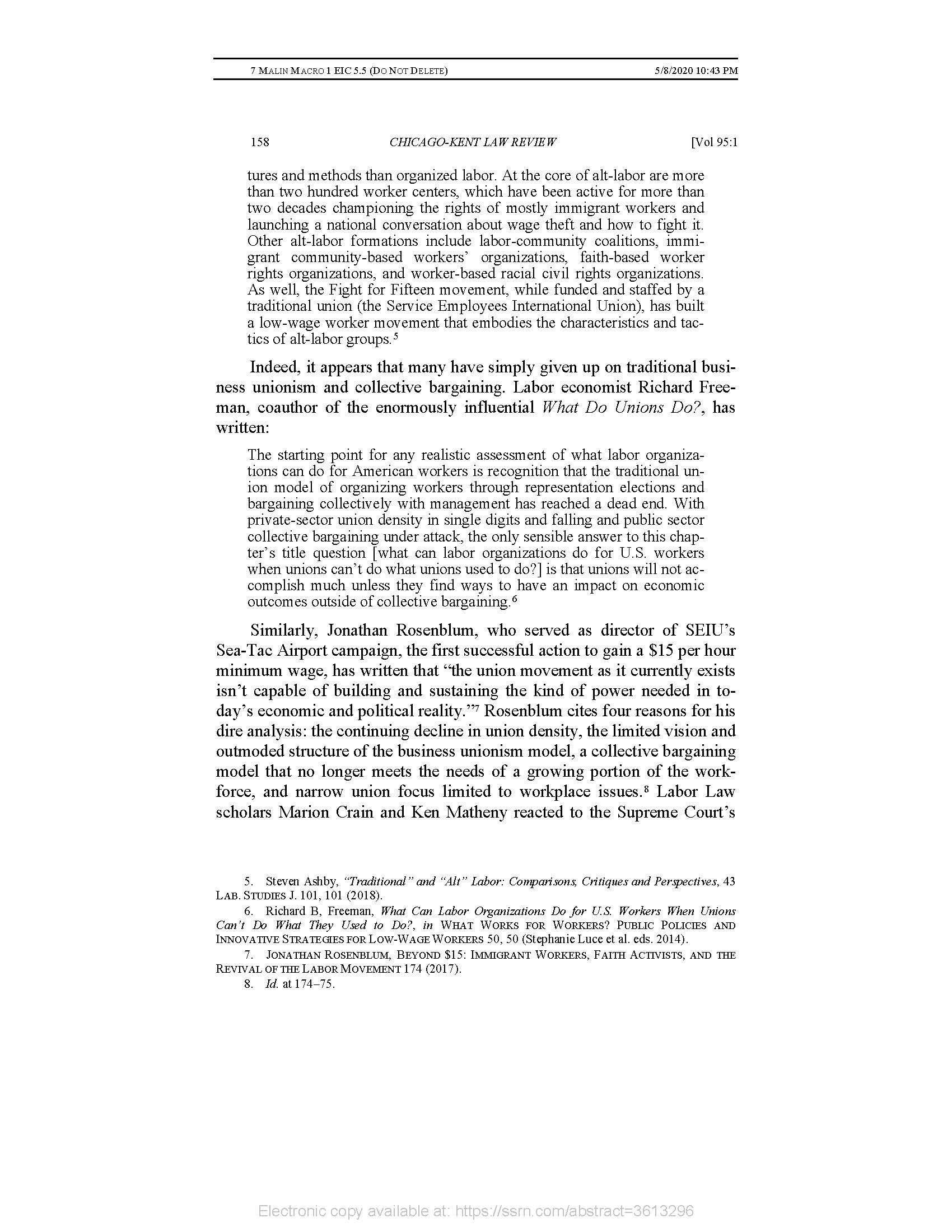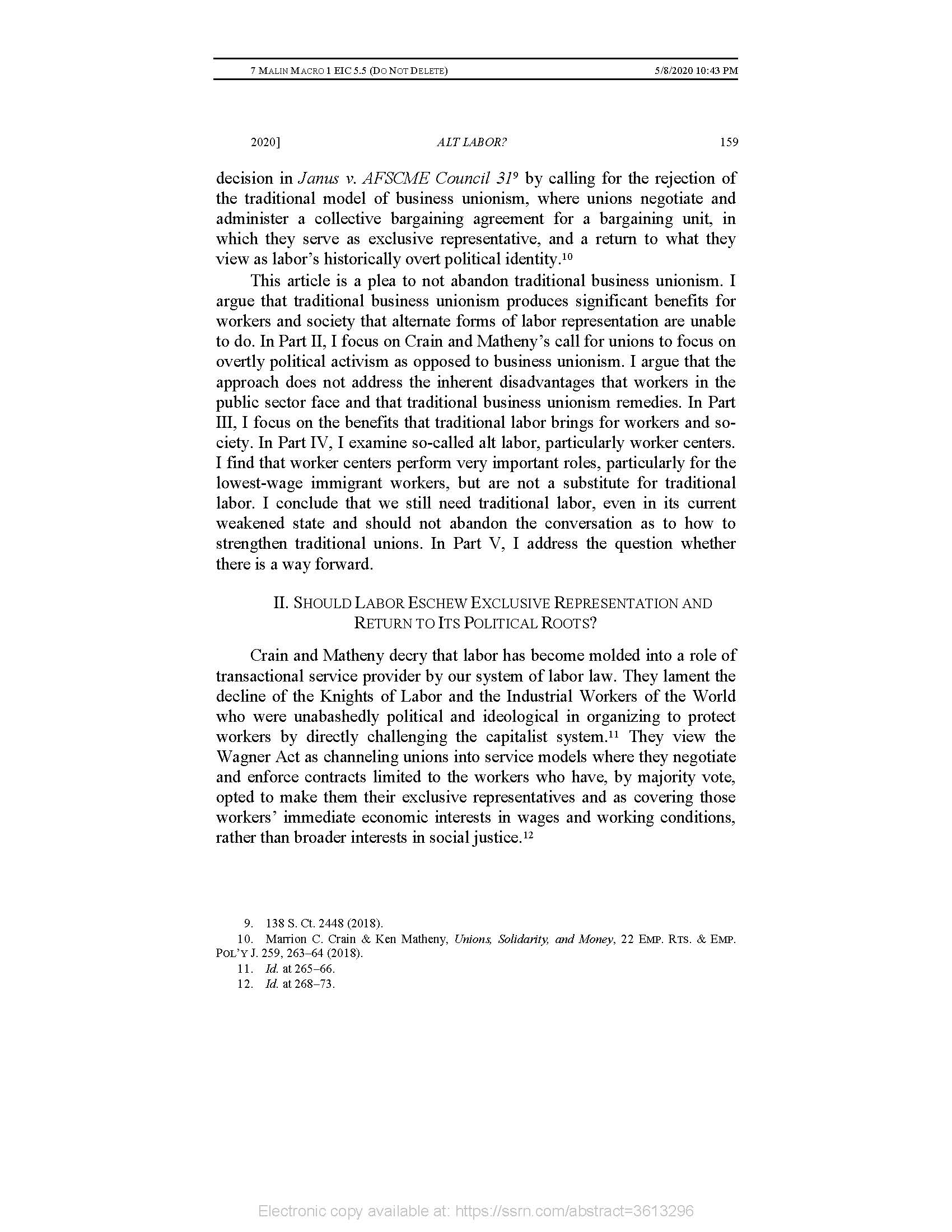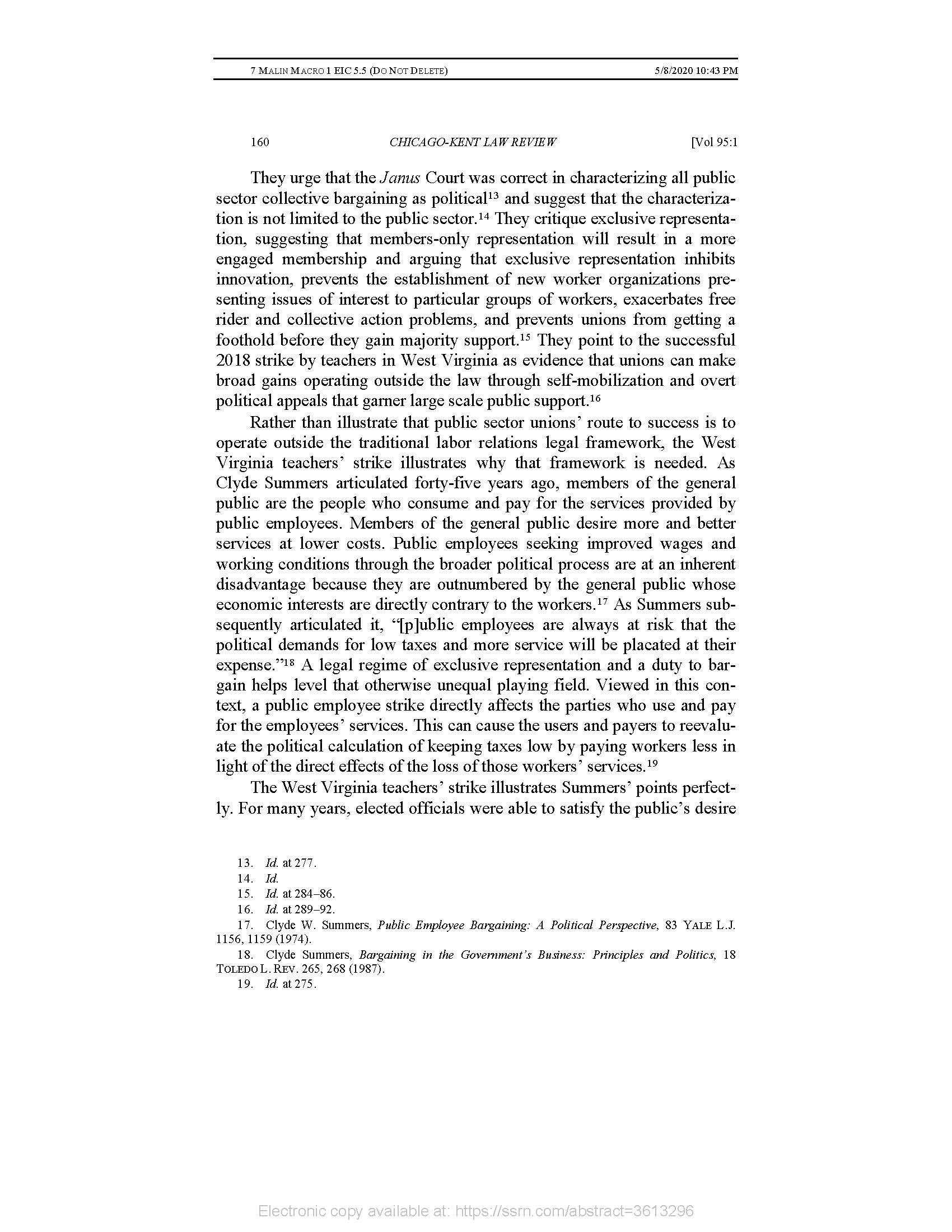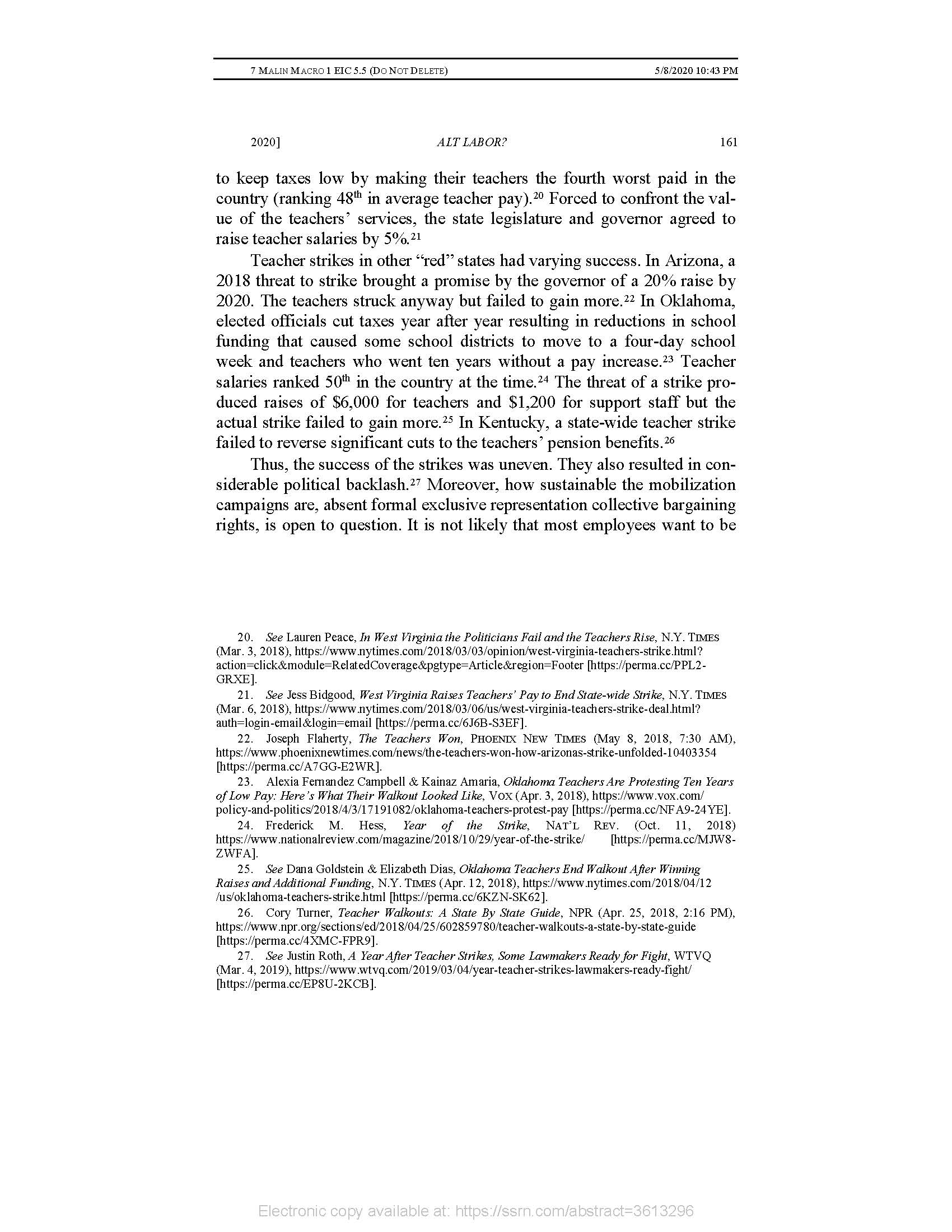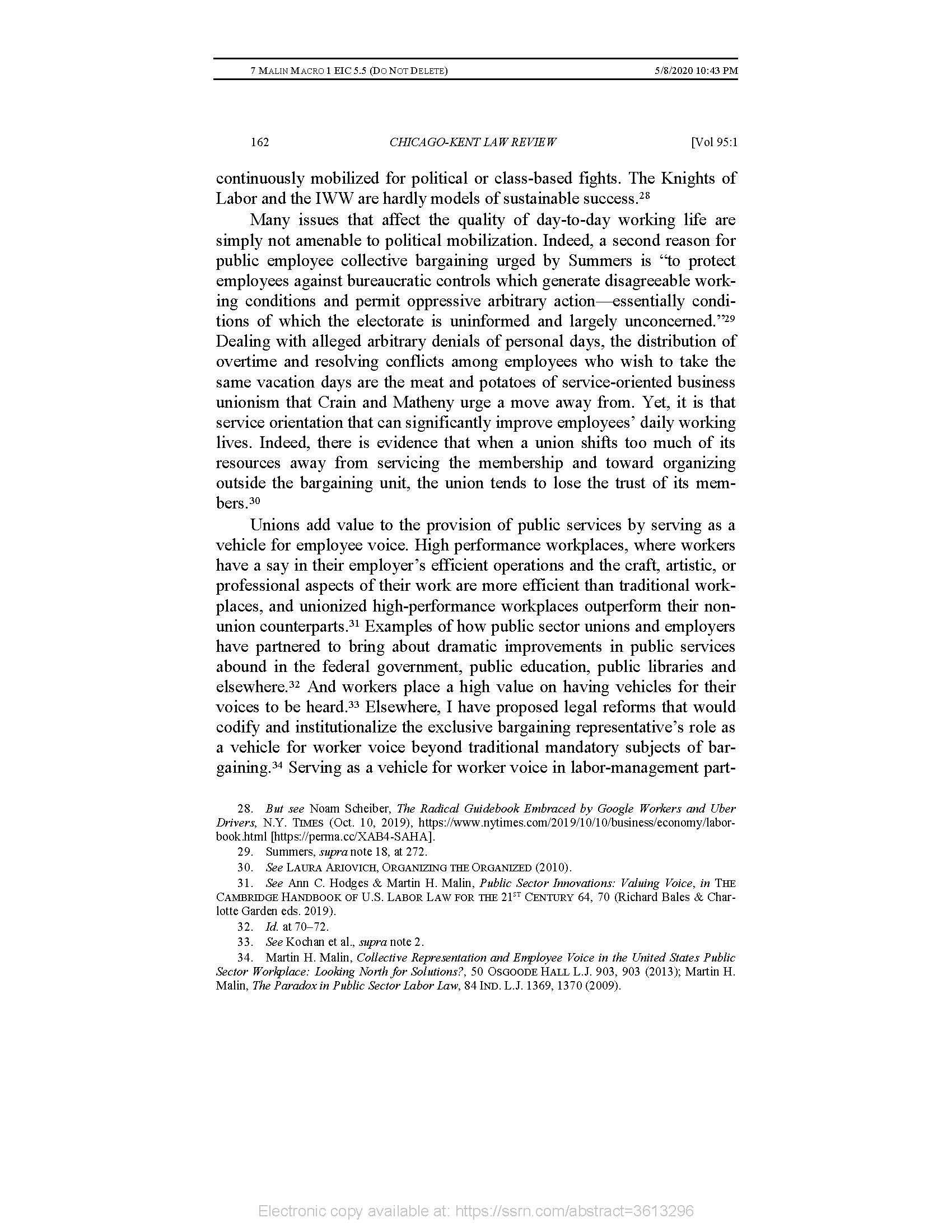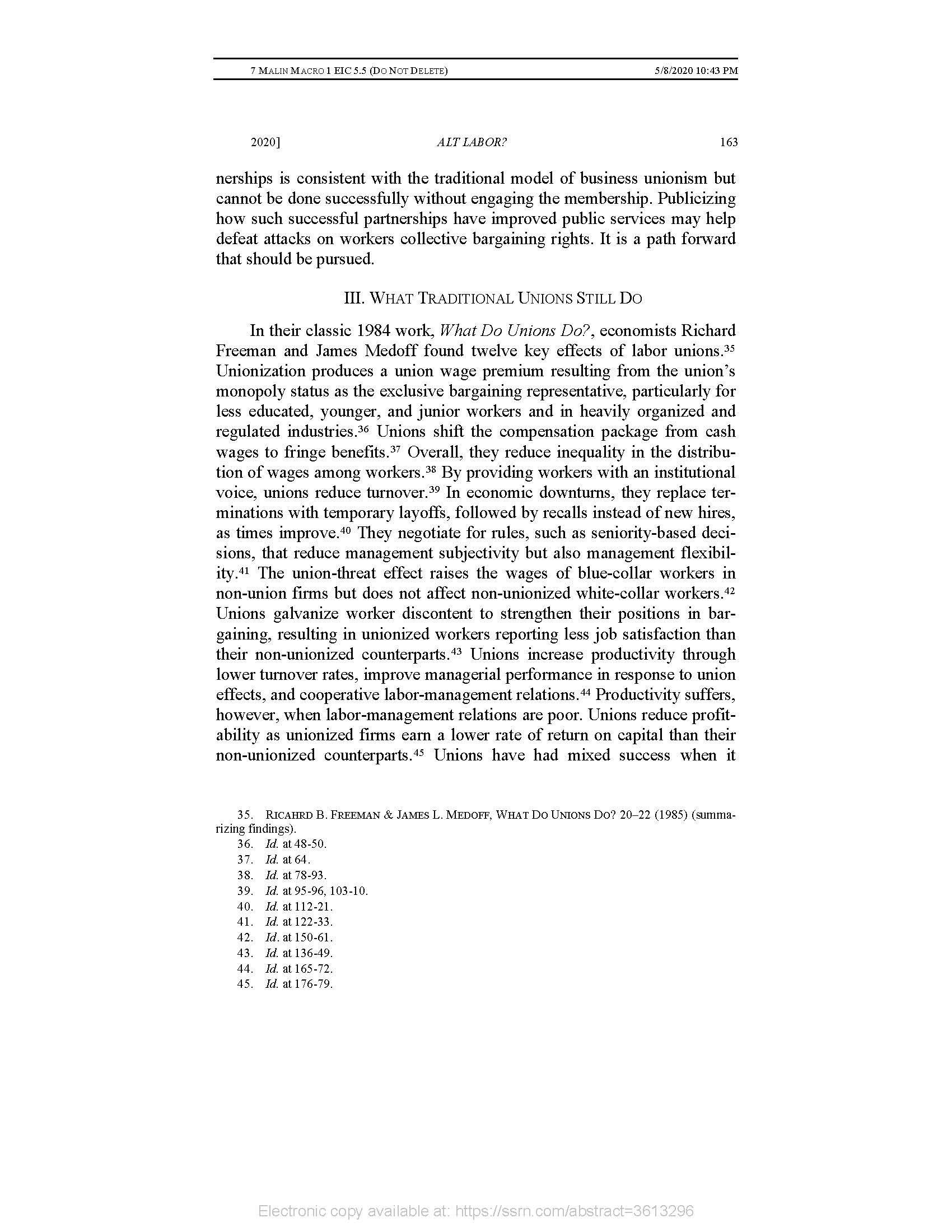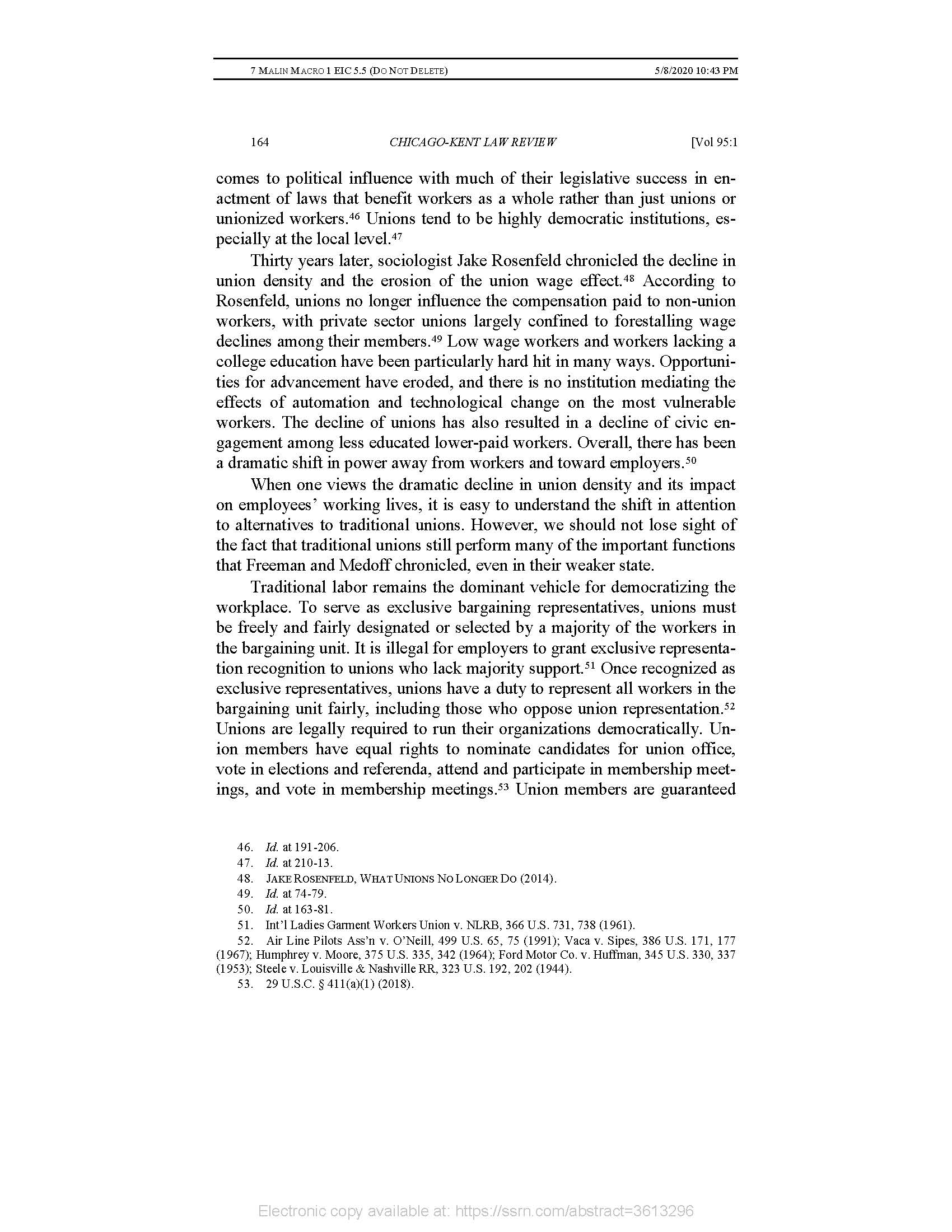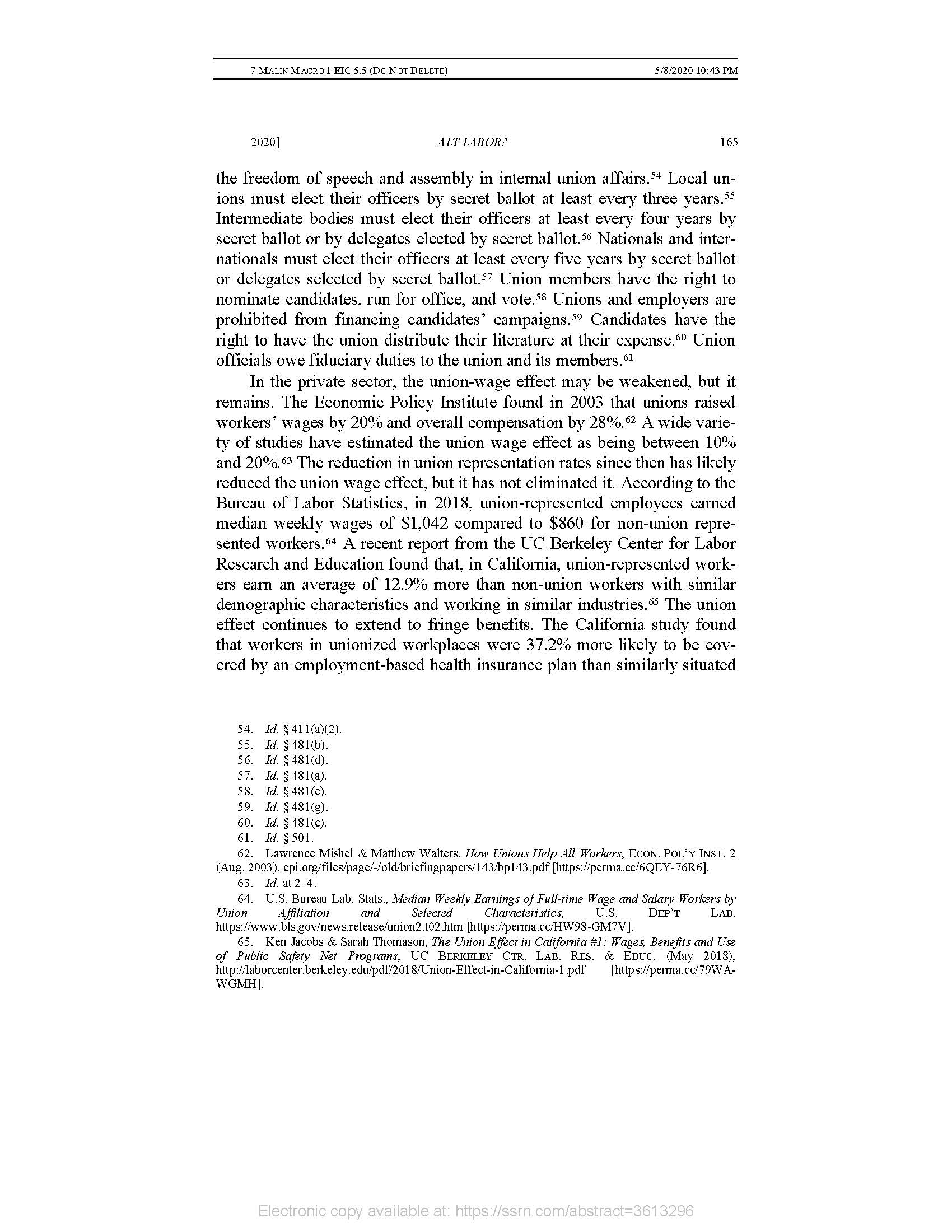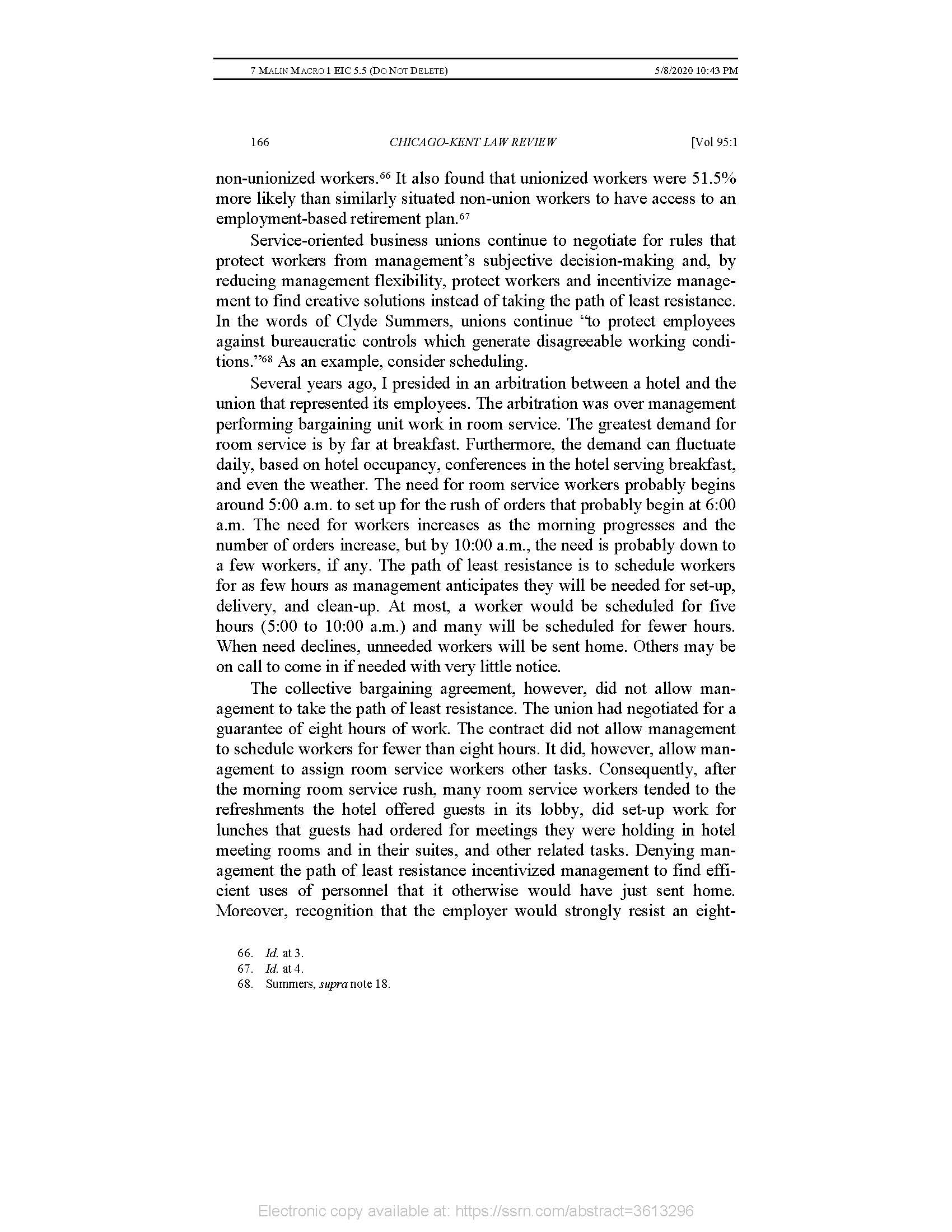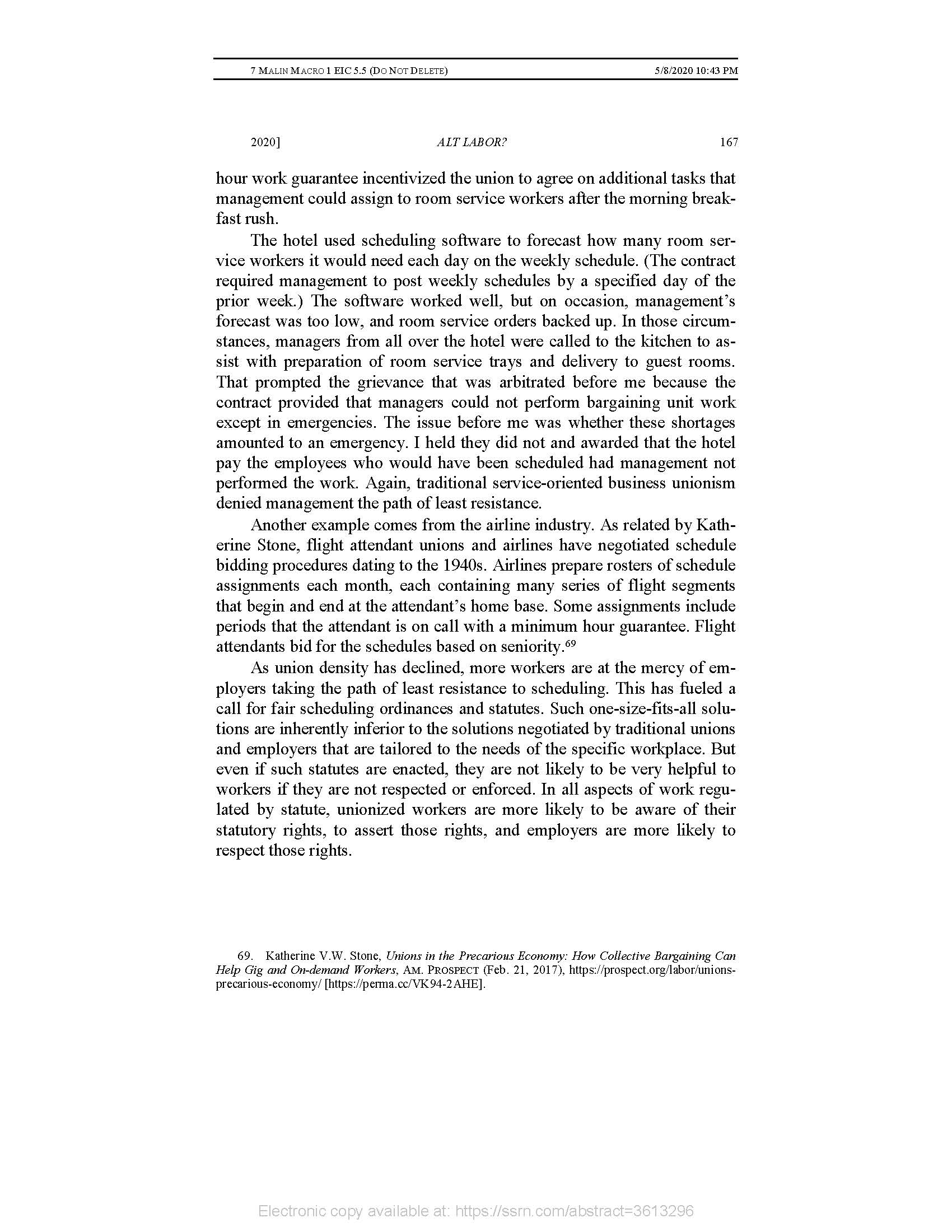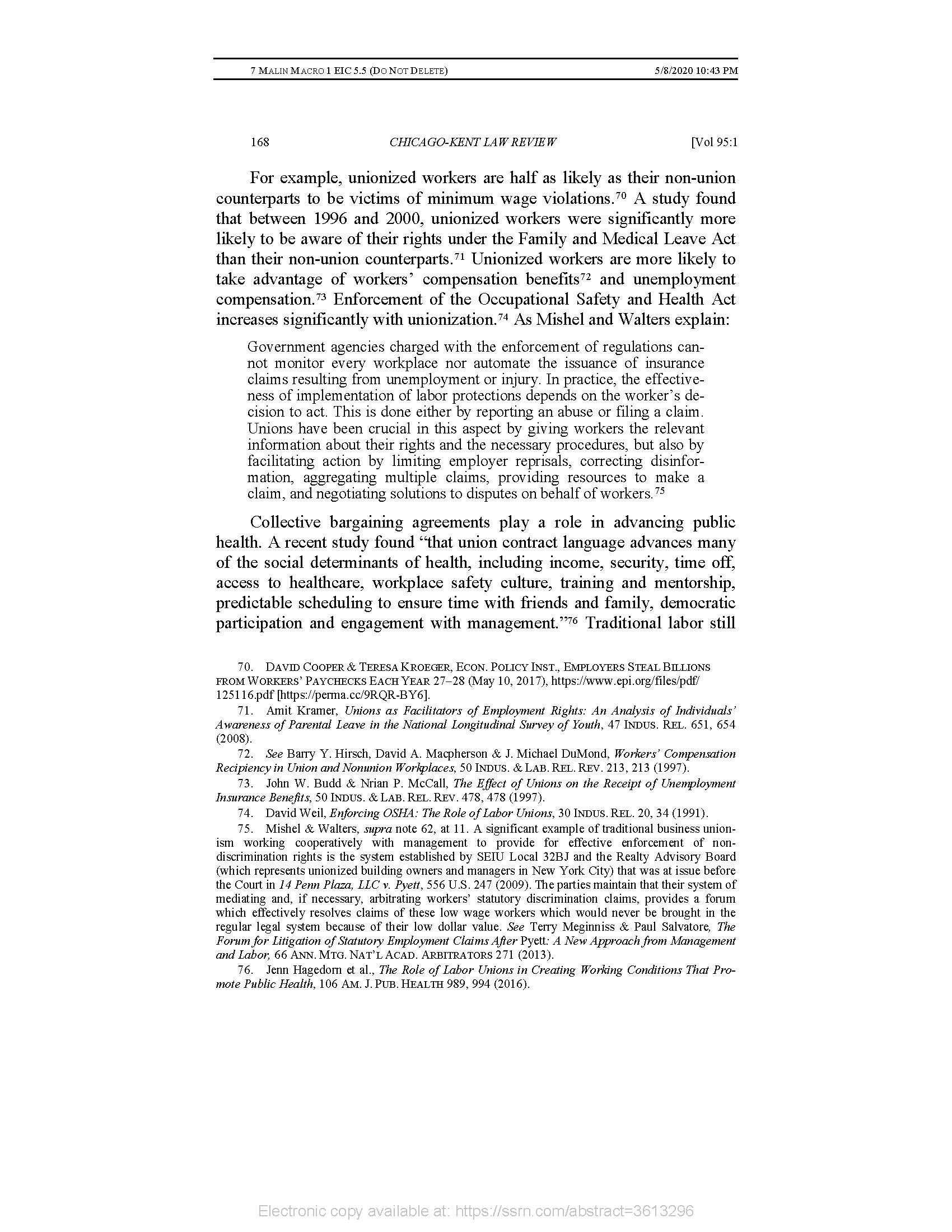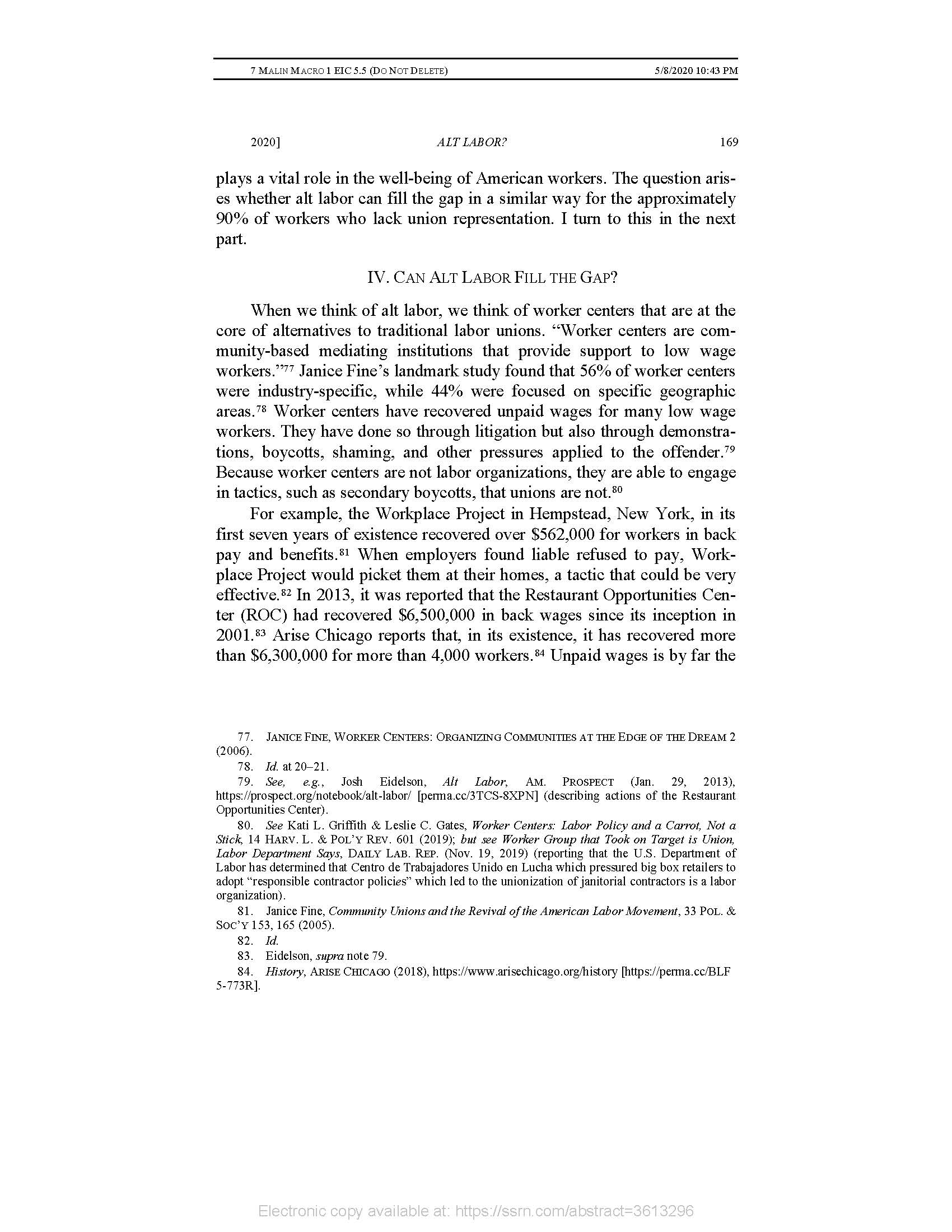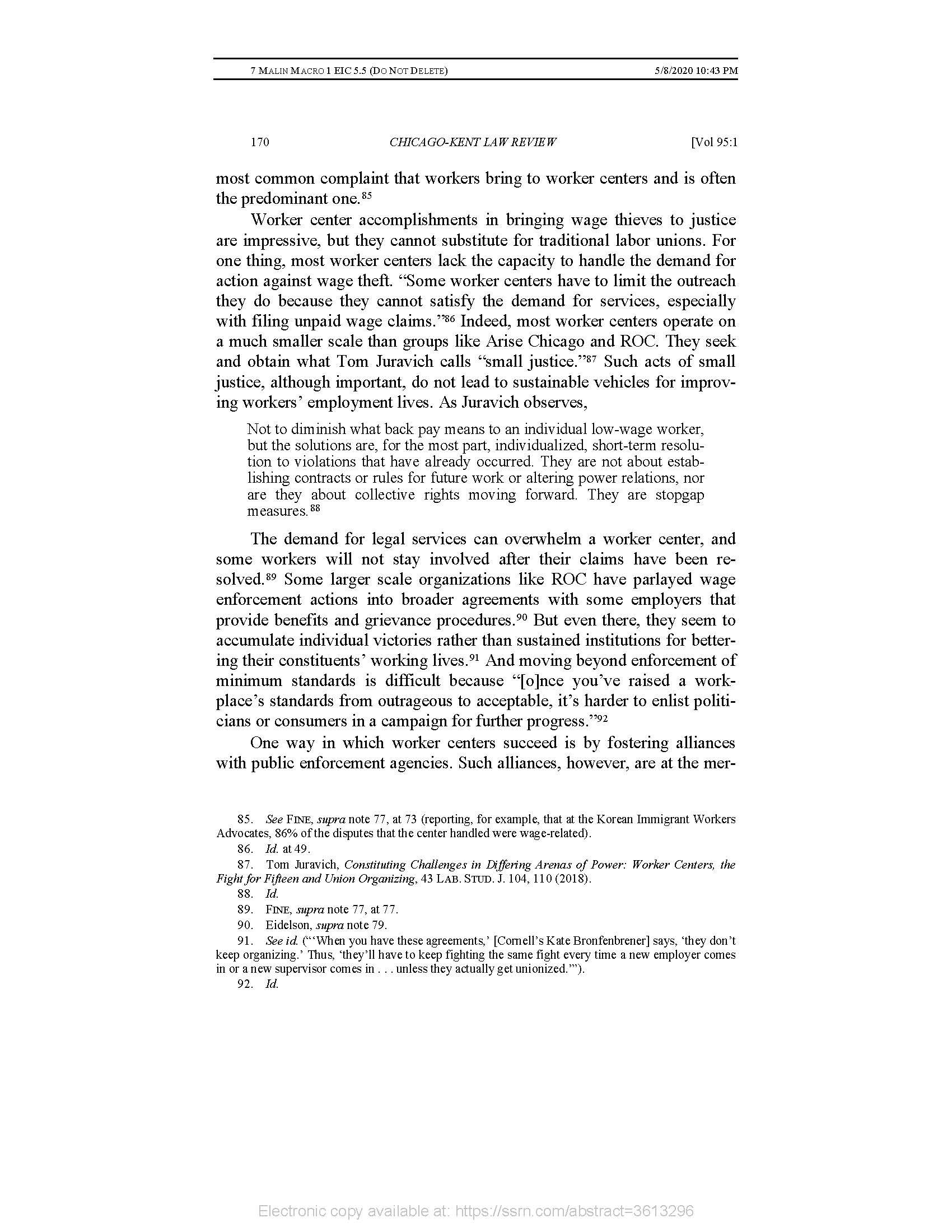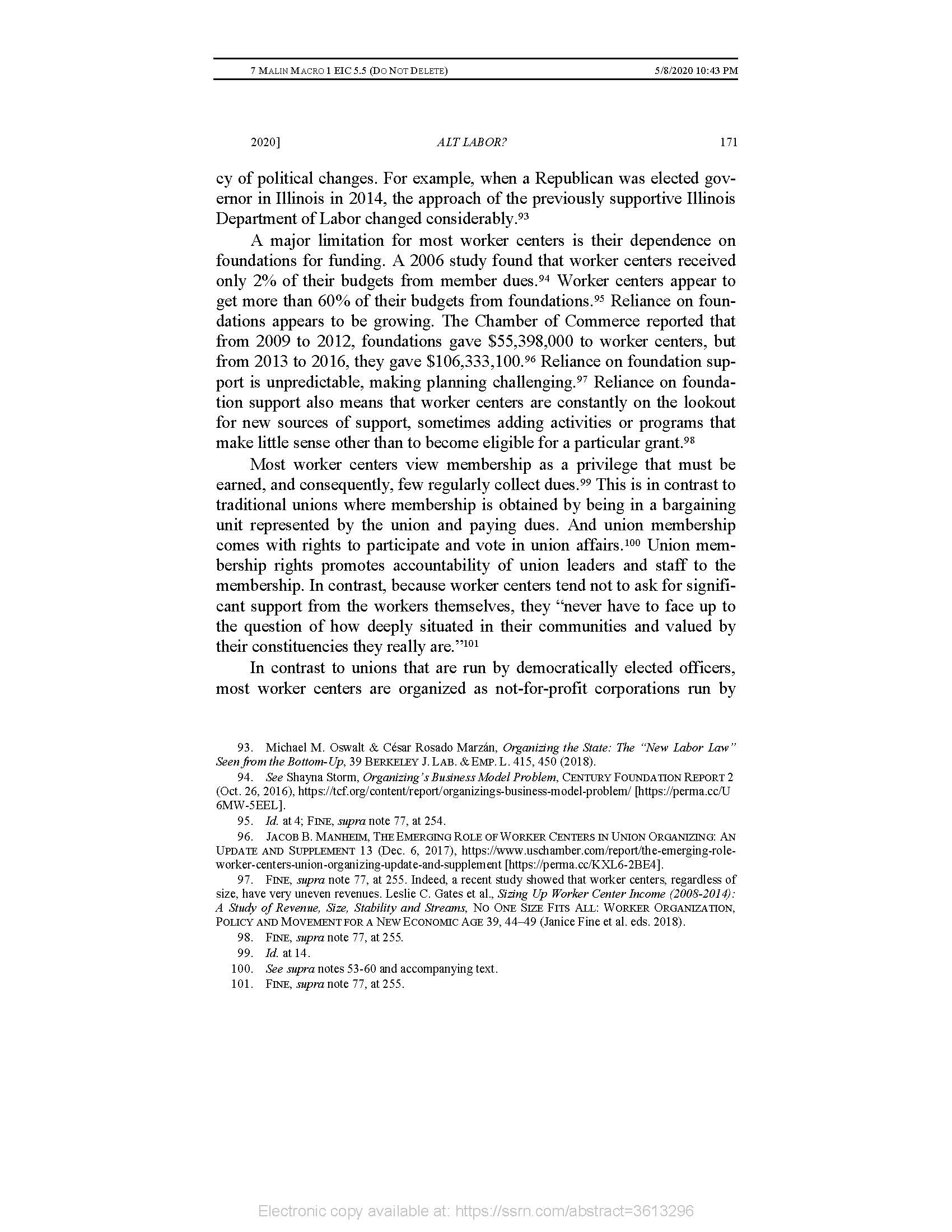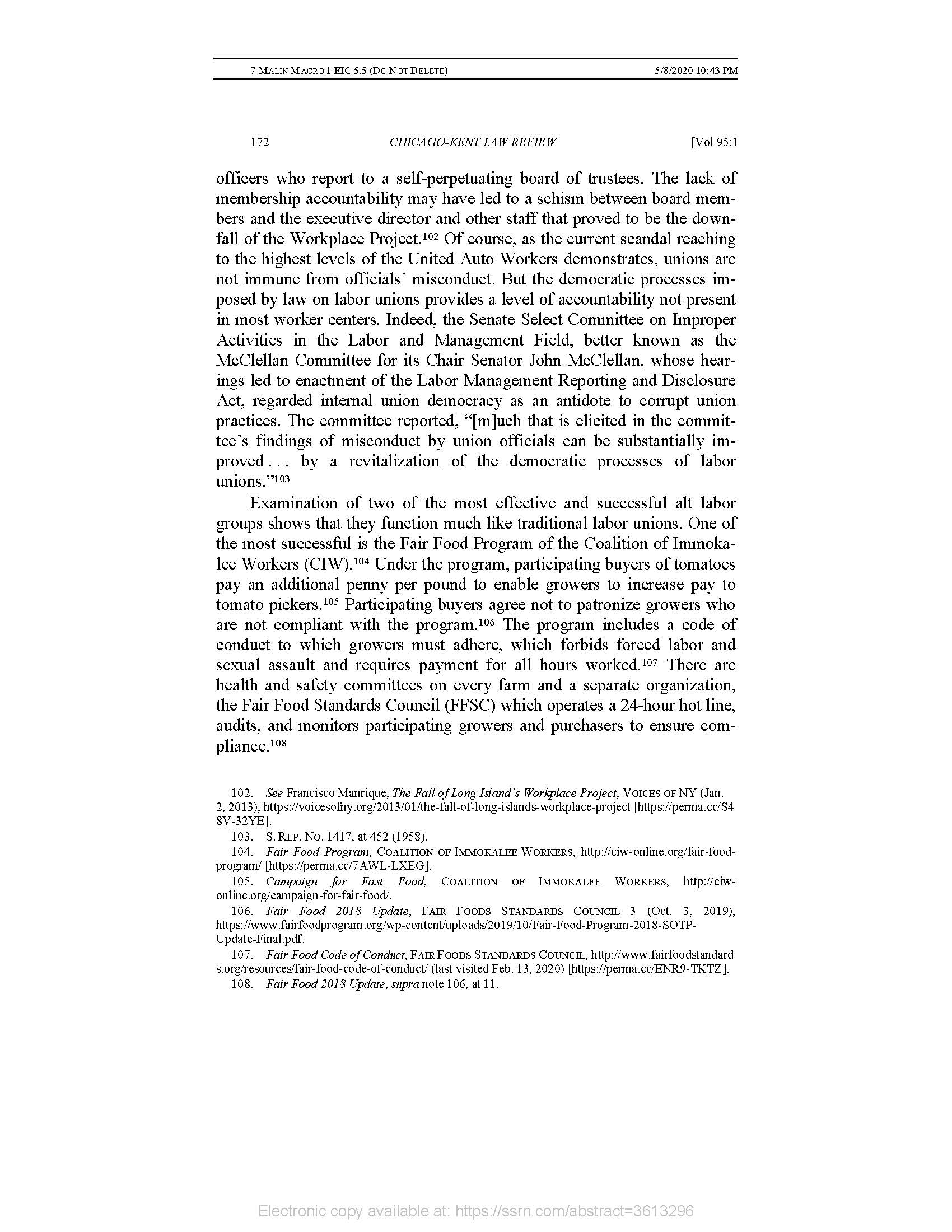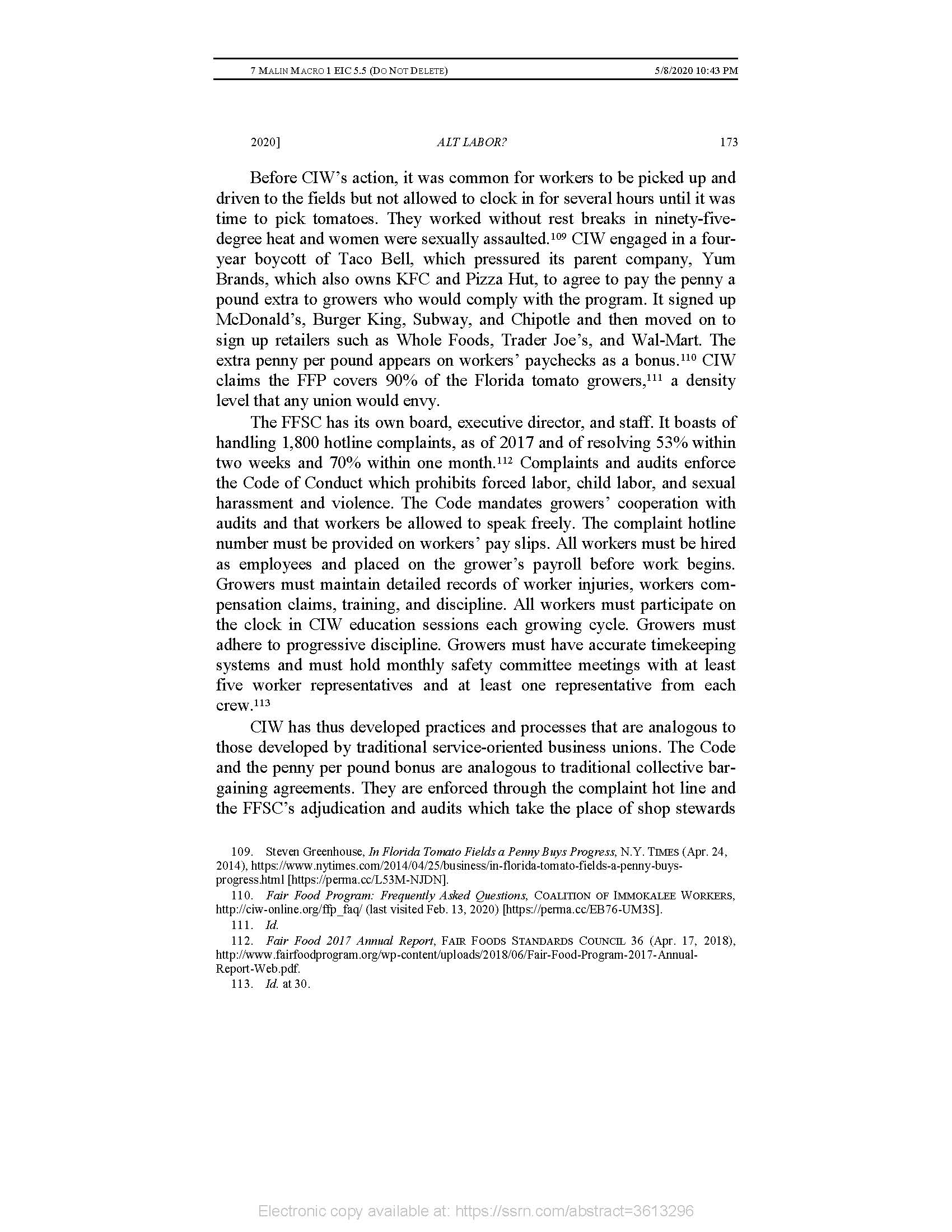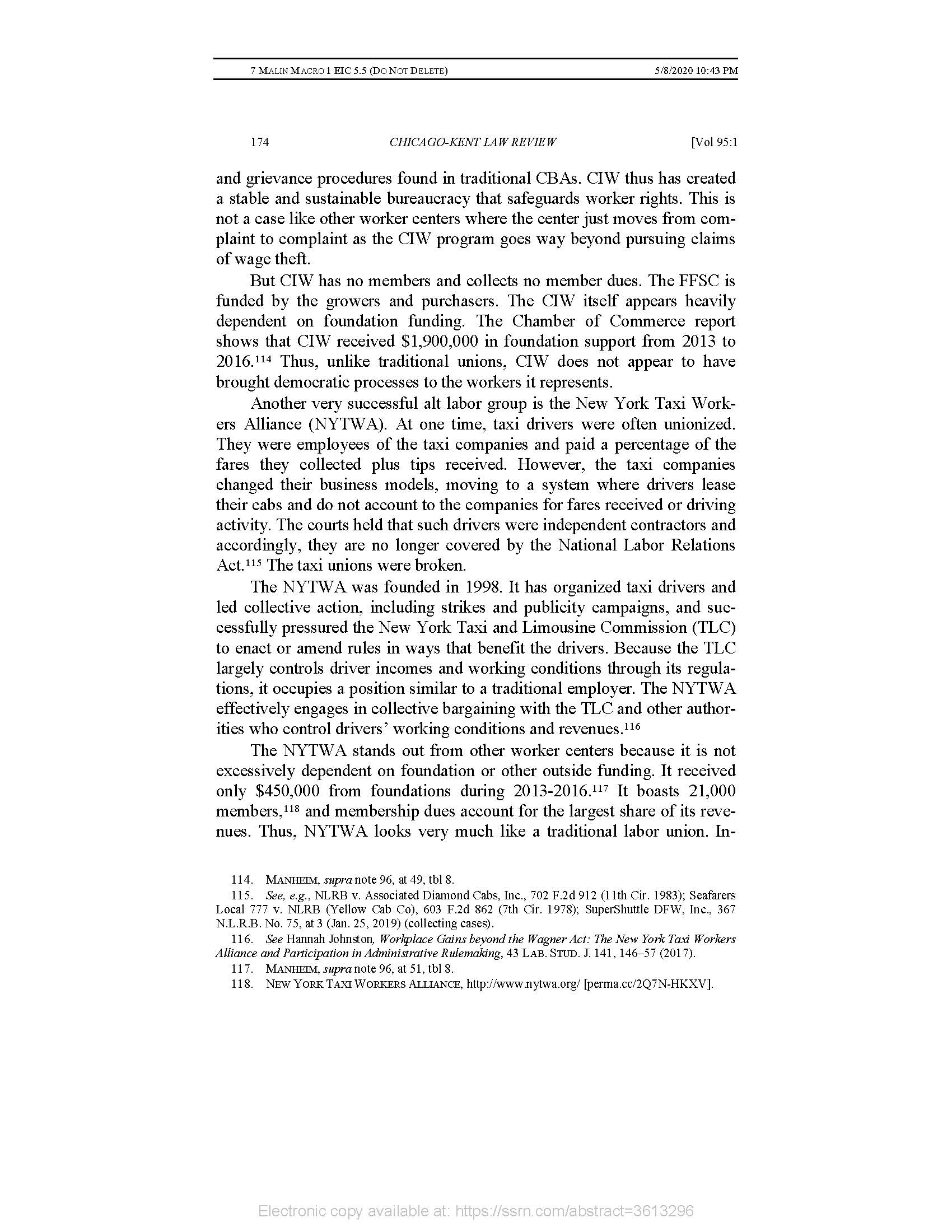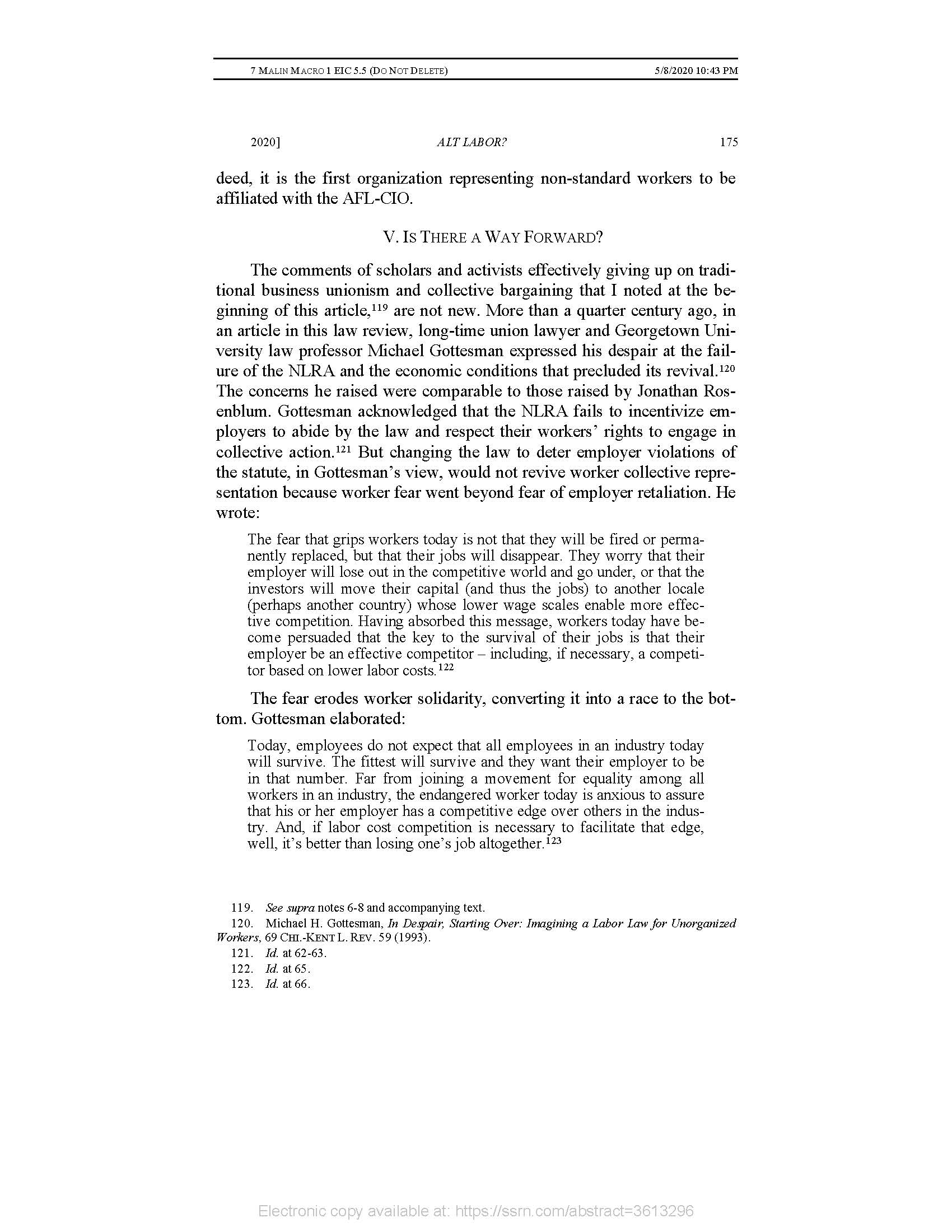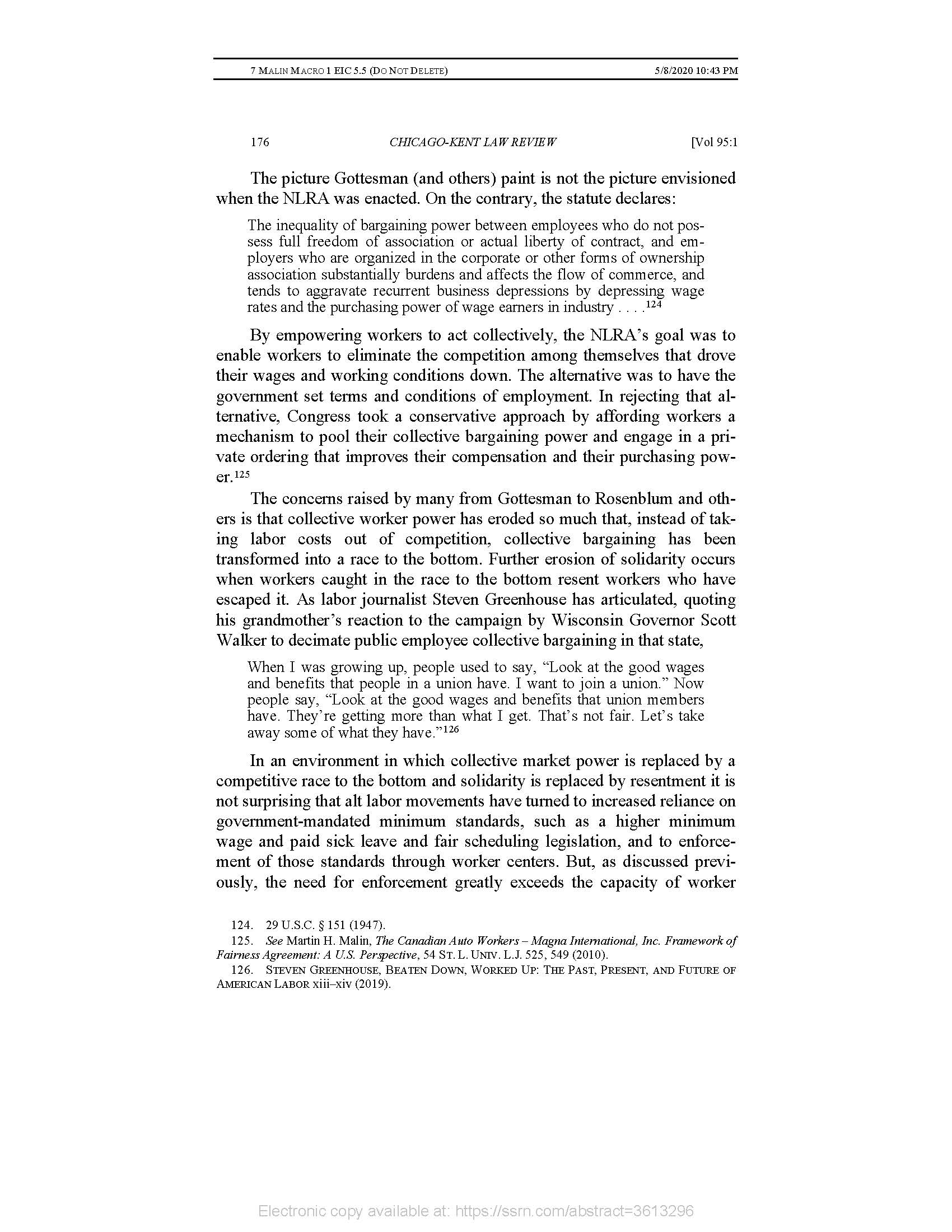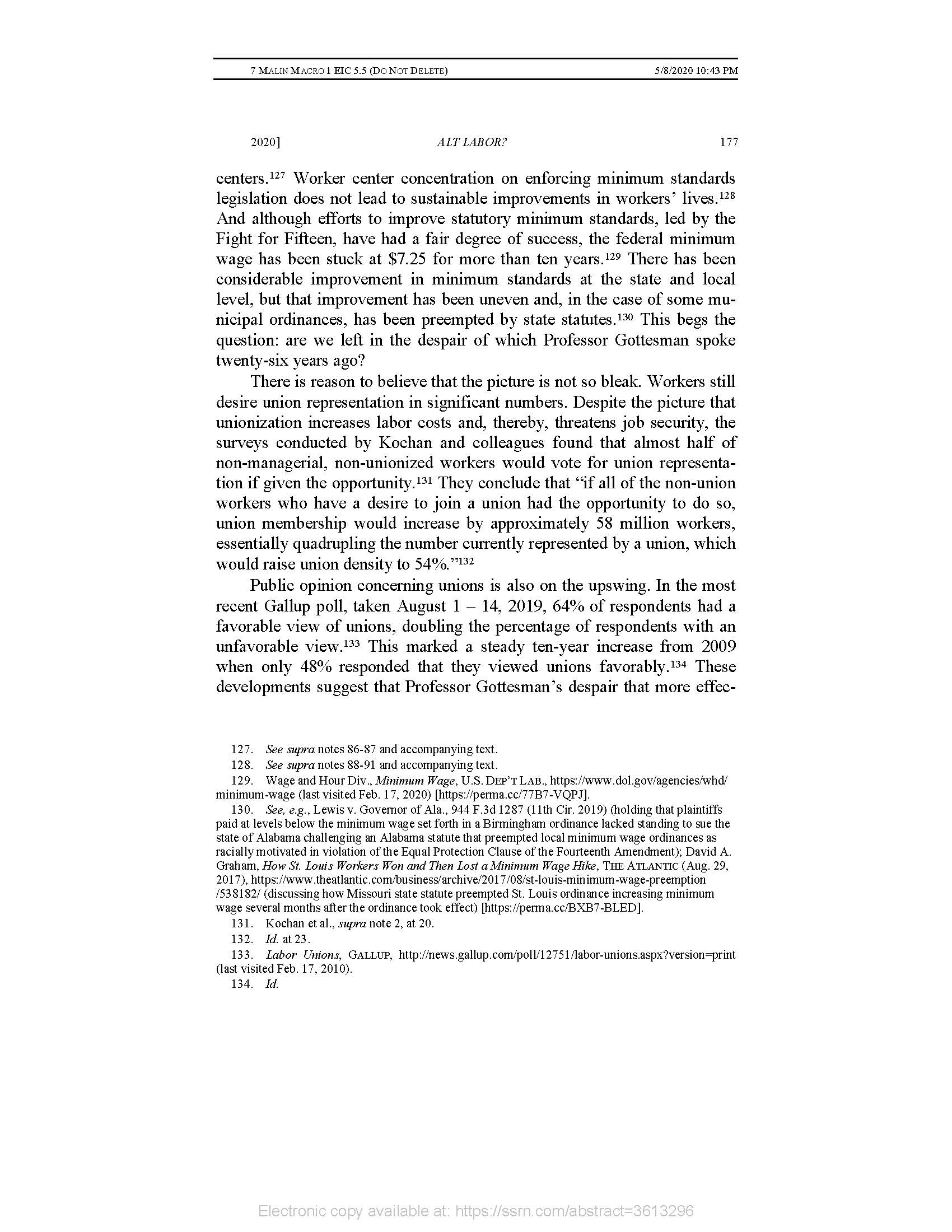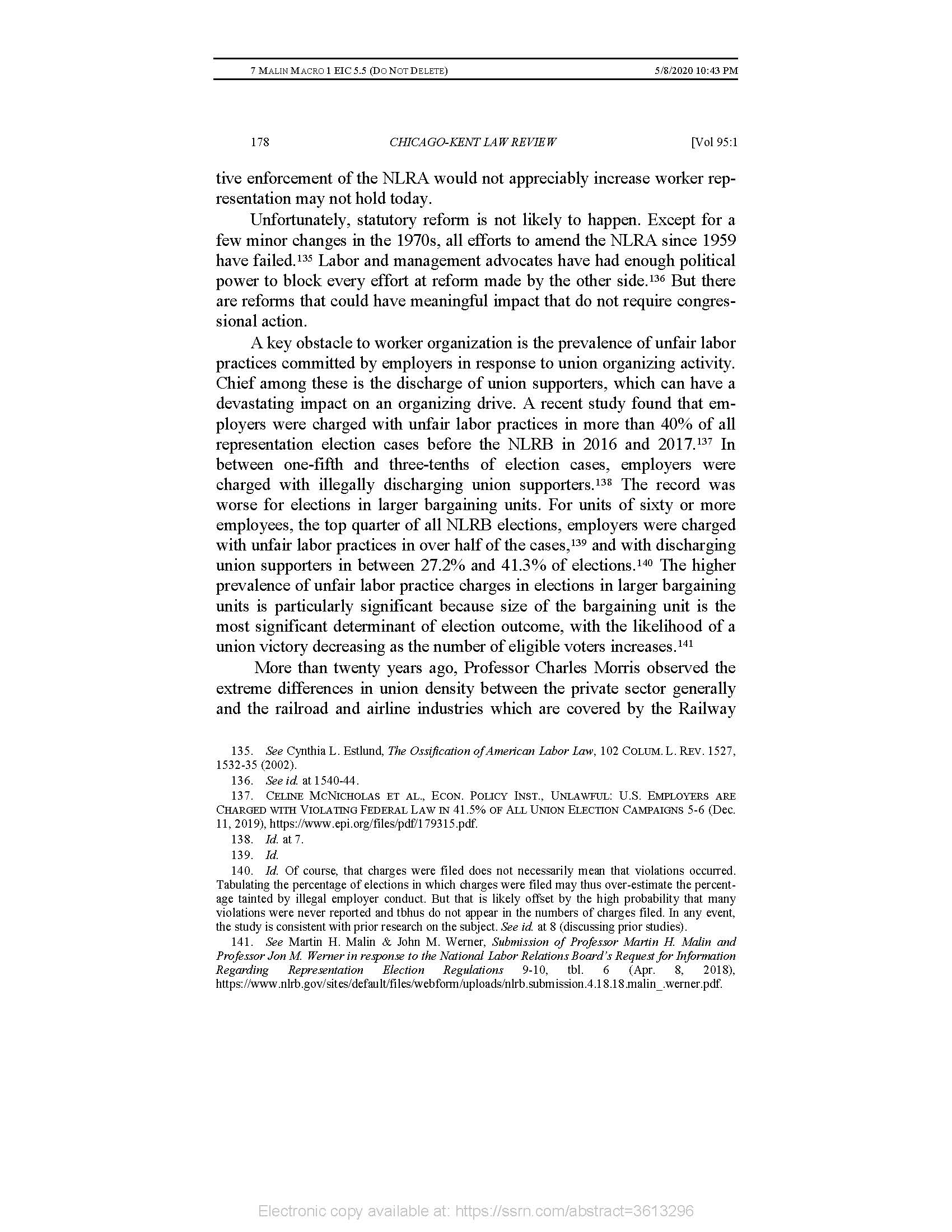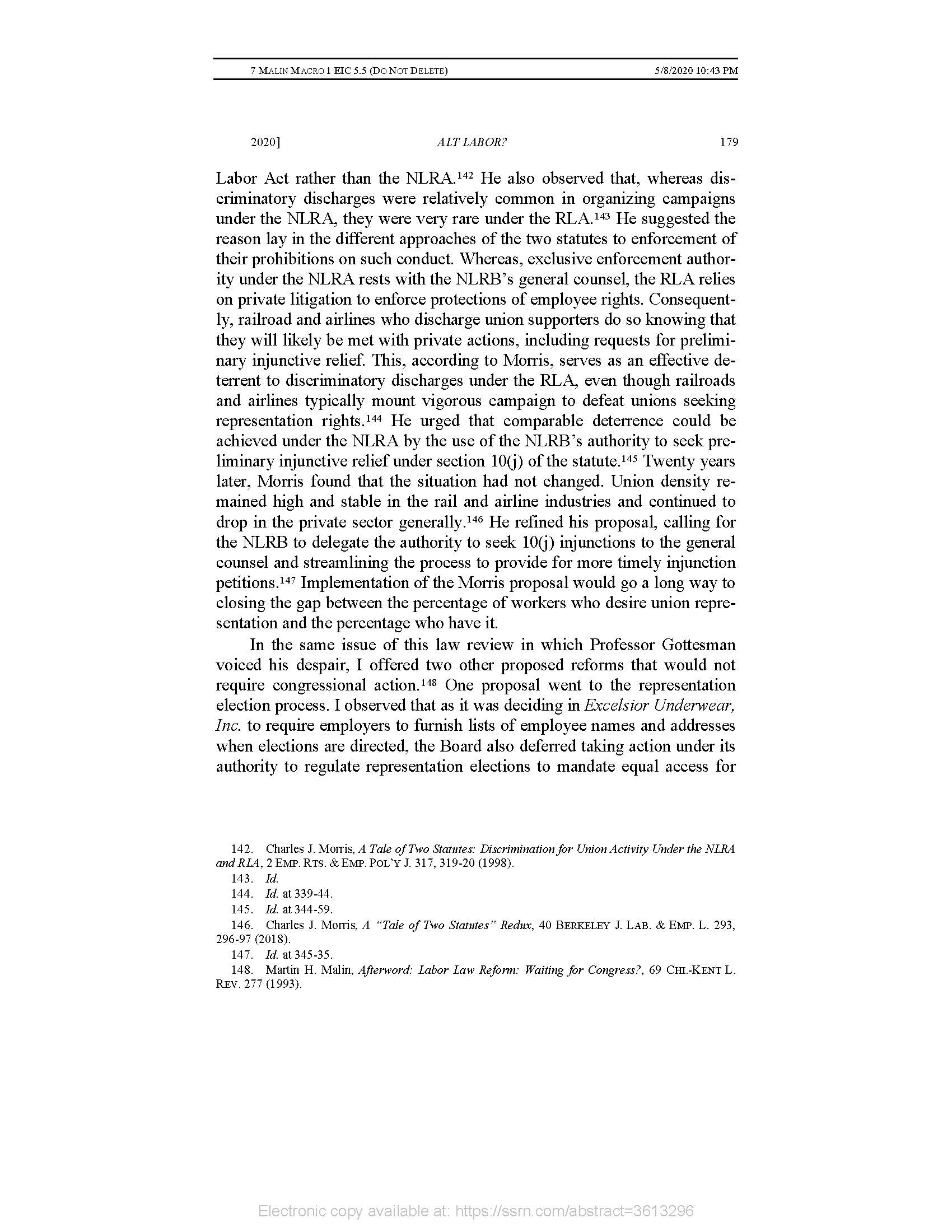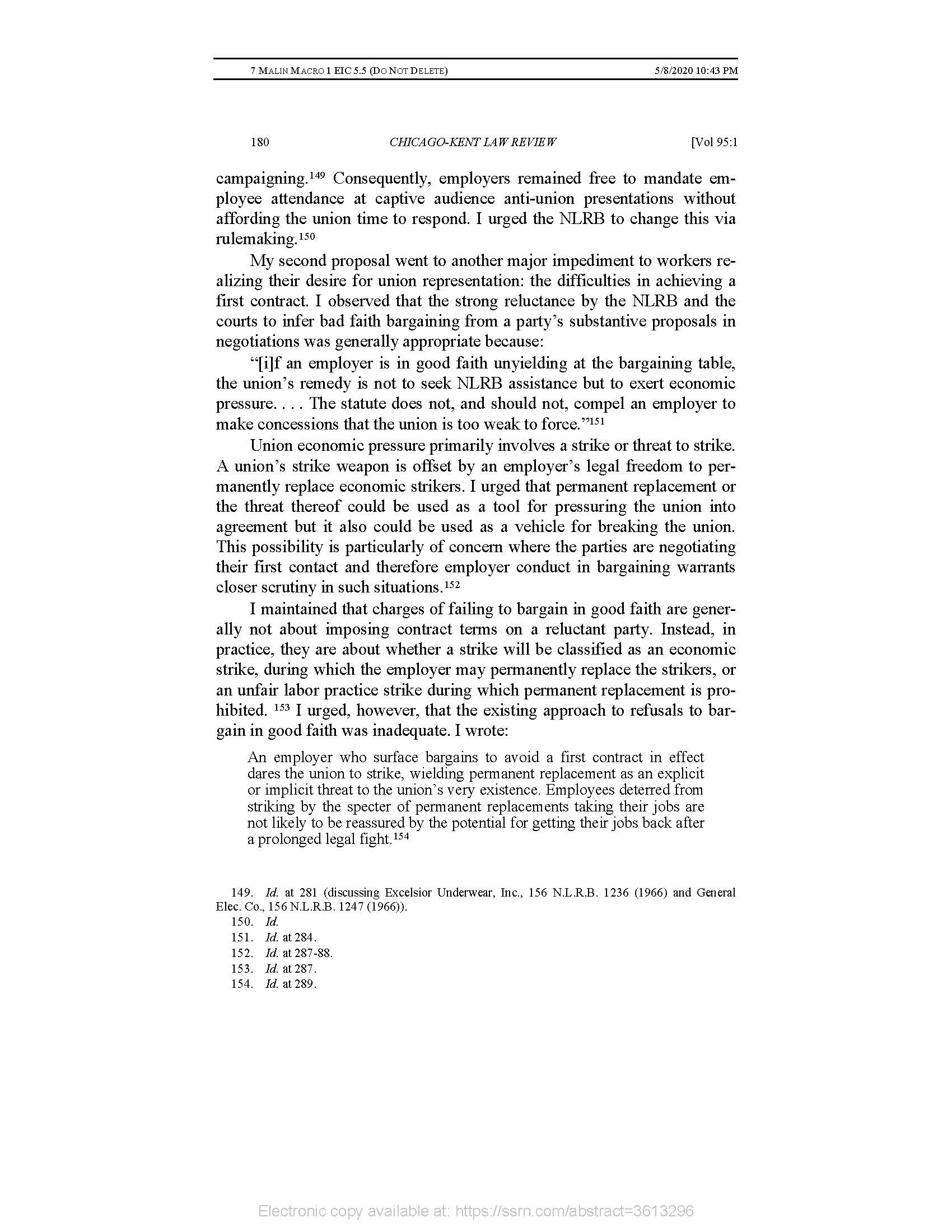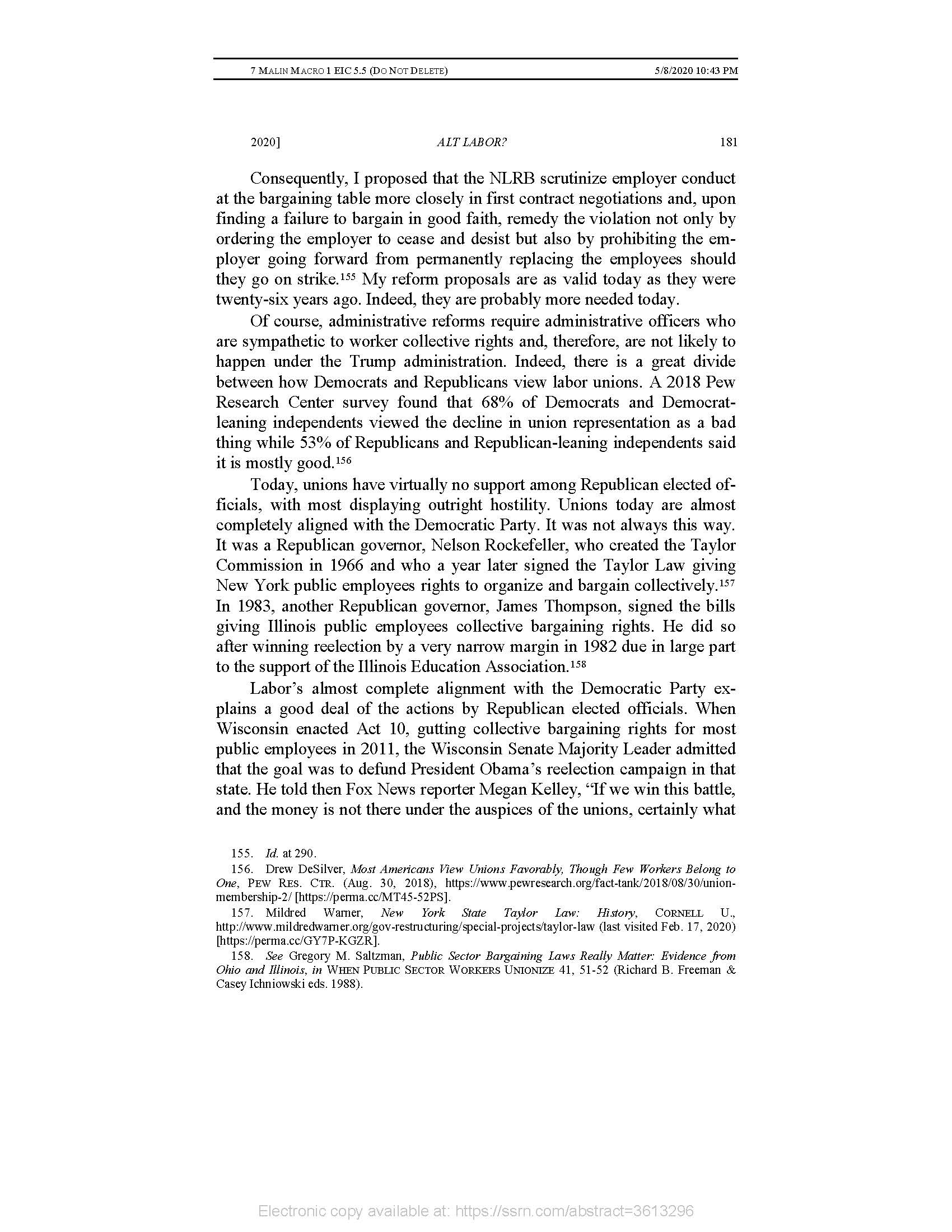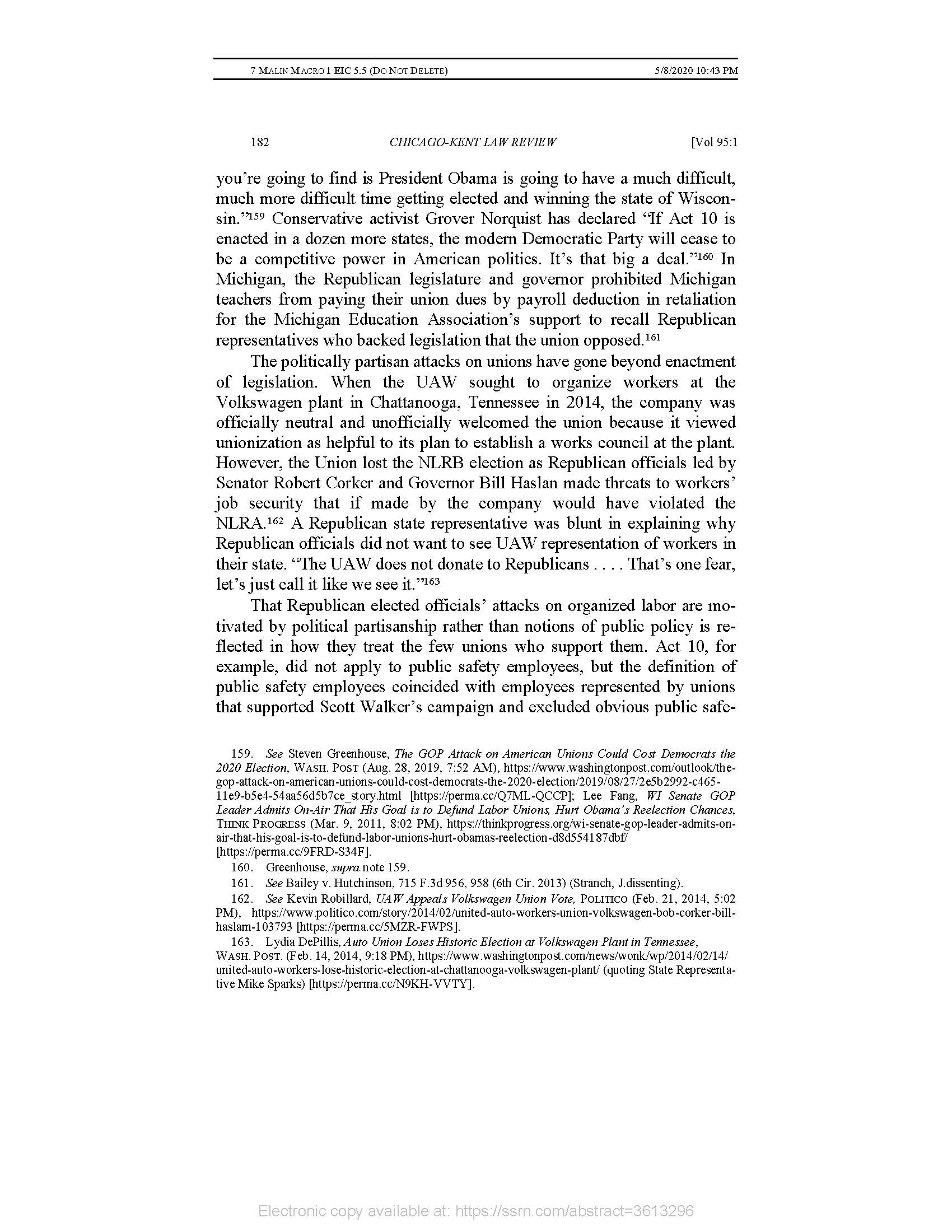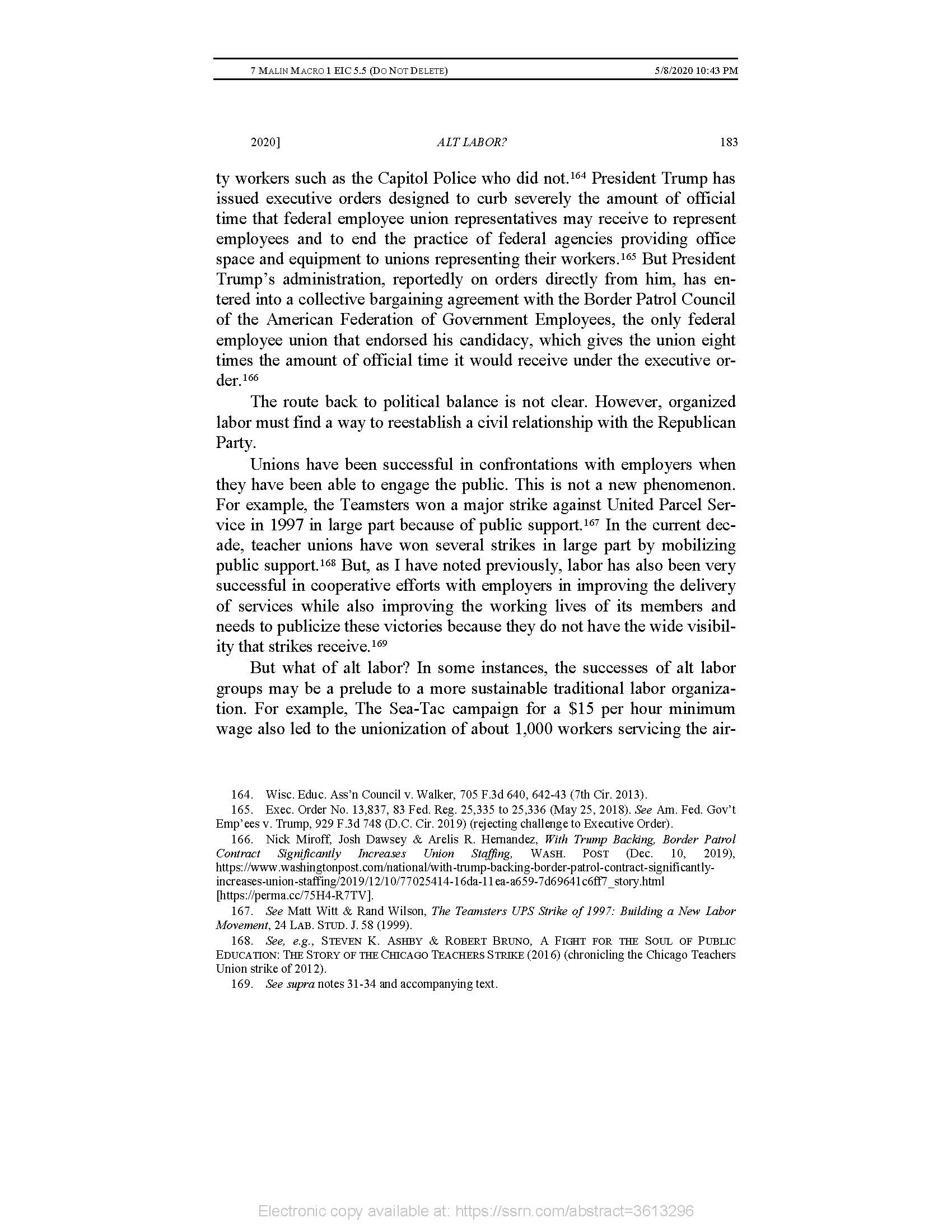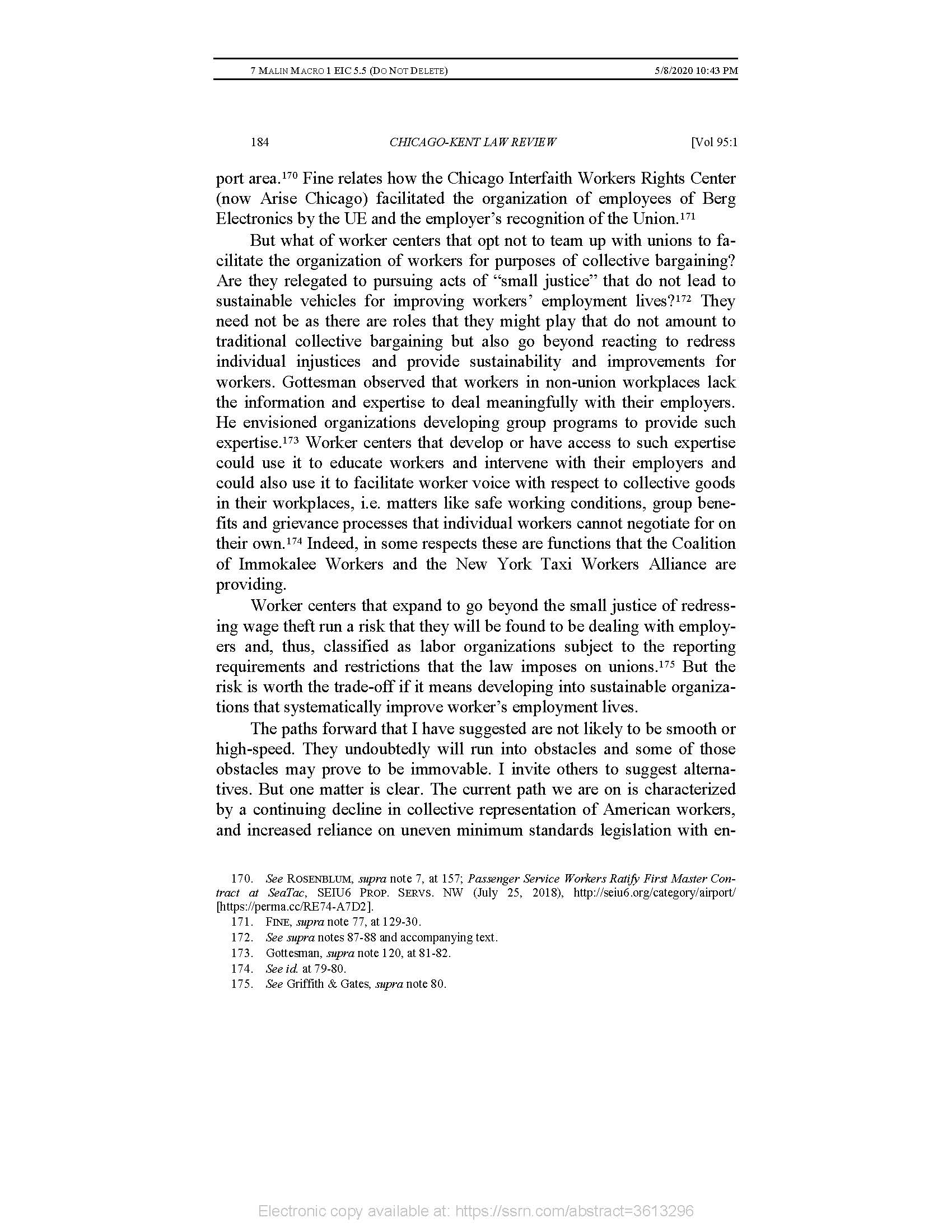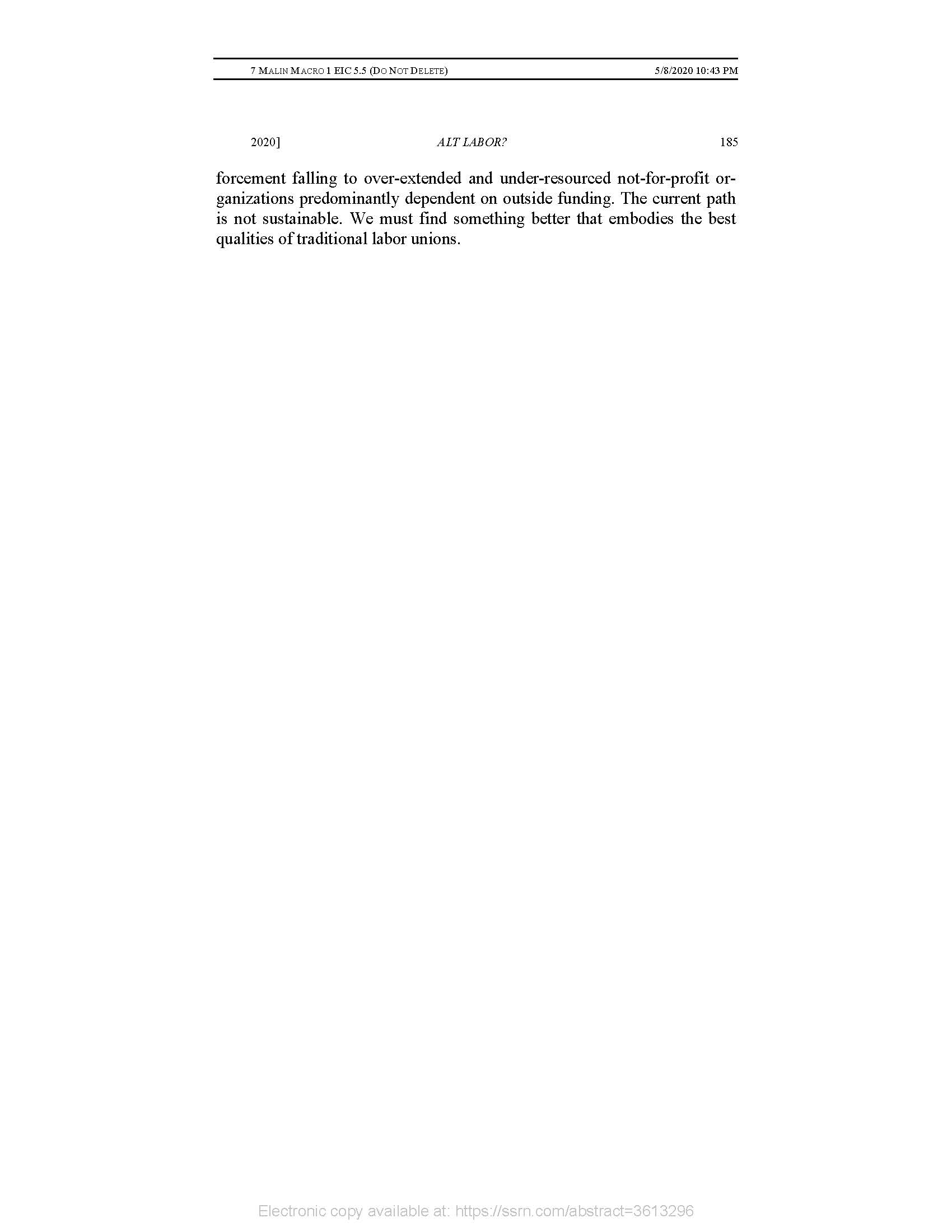Alt Labor? Why We Still Need Traditional Labor
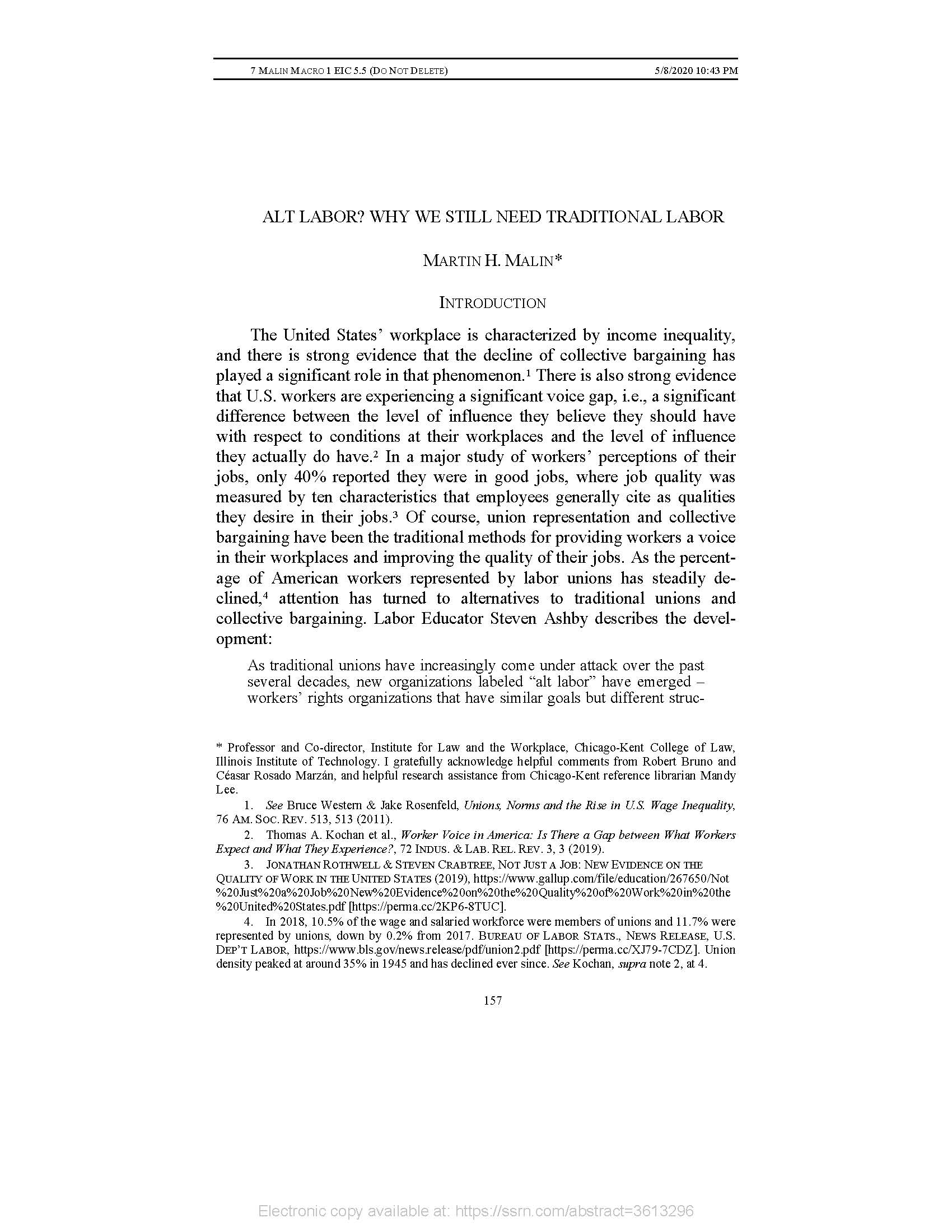 Chicago-Kent Law Review, Vol. 95, No. 1, 2020
Chicago-Kent Law Review, Vol. 95, No. 1, 2020
29 Pages Posted: 23 Jun 2020
https://papers.ssrn.com/sol3/papers.cfm?abstract_id=3613296
Chicago-Kent College of Law - Illinois Institute of Technology
Date Written: May 8, 2020
Abstract
With union density falling to alarmingly low levels and dropping, many have largely written off traditional business unionism and have turned to so-called alt-labor forms of worker empowerment, particularly worker centers. But traditional unions continue to provide valuable service to the workers they represent and to society as a whole. The union wage premium may not be as strong as it once was but it still remains and workers represented by unions are far more likely to have health and retirement benefits than their unrepresented counterparts. Moreover, it is through traditional transactional business unionism, that workers find protection from disagreeable working conditions and arbitrary management actions. And unions are legally required to be democratically run. Worker centers, on the other hand, while doing a laudable job of obtaining justice for low wage workers, particularly with respect to wage theft, generally do not provide sustainable continuing representation of workers with their employers, are not accountable to the workers they represent, are financially dependent on unstable foundation funding, and, even with respect to wage claims, often have to limit their intake so as not to exceed their capacity. Moreover, while some groups thought of as alt-labor, such as the Fight for Fifteen, have succeeded at the state and local level in securing worker-protective legislation, particularly increases in the minimum wage, union-represented workers are far more likely to be aware of and take advantage of statutory workplace rights. This article urges that we not abandon traditional business unionism and suggests a few ways forward that may help restore traditional labor unions’ roles in representing workers in the United States.
INTRODUCTION
The United States’ workplace is characterized by income inequality, and there is strong evidence that the decline of collective bargaining has played a significant role in that phenomenon.1 There is also strong evidence that U.S. workers are experiencing a significant voice gap, i.e., a significant difference between the level of influence they believe they should have with respect to conditions at their workplaces and the level of influence they actually do have.2 In a major study of workers’ perceptions of their jobs, only 40% reported they were in good jobs, where job quality was measured by ten characteristics that employees generally cite as qualities they desire in their jobs.3 Of course, union representation and collective bargaining have been the traditional methods for providing workers a voice in their workplaces and improving the quality of their jobs. As the percent-age of American workers represented by labor unions has steadily declined,4 attention has turned to alternatives to traditional unions and collective bargaining. Labor Educator Steven Ashby describes the development:
As traditional unions have increasingly come under attack over the past several decades, new organizations labeled “alt labor” have emerged – workers’ rights organizations that have similar goals but different structures and methods than organized labor. At the core of alt-labor are more than two hundred worker centers, which have been active for more than two decades championing the rights of mostly immigrant workers and launching a national conversation about wage theft and how to fight it. Other alt-labor formations include labor-community coalitions, immi- grant community-based workers’ organizations, faith-based worker rights organizations, and worker-based racial civil rights organizations. As well, the Fight for Fifteen movement, while funded and staffed by a traditional union (the Service Employees International Union), has built a low-wage worker movement that embodies the characteristics and tac- tics of alt-labor groups.
Indeed, it appears that many have simply given up on traditional busi- ness unionism and collective bargaining. Labor economist Richard Free- man, coauthor of the enormously influential What Do Unions Do?, has written:
The starting point for any realistic assessment of what labor organiza- tions can do for American workers is recognition that the traditional un- ion model of organizing workers through representation elections and bargaining collectively with management has reached a dead end. With private-sector union density in single digits and falling and public sector collective bargaining under attack, the only sensible answer to this chap- ter’s title question [what can labor organizations do for U.S. workers when unions can’t do what unions used to do?] is that unions will not ac- complish much unless they find ways to have an impact on economic outcomes outside of collective bargaining.
Similarly, Jonathan Rosenblum, who served as director of SEIU’s Sea-Tac Airport campaign, the first successful action to gain a $15 per hour minimum wage, has written that “the union movement as it currently exists isn’t capable of building and sustaining the kind of power needed in today’s economic and political reality.”
Rosenblum cites four reasons for his dire analysis: the continuing decline in union density, the limited vision and outmoded structure of the business unionism model, a collective bargaining model that no longer meets the needs of a growing portion of the work- force, and narrow union focus limited to workplace issues.8 Labor Law scholars Marion Crain and Ken Matheny reacted to the Supreme Court’s decision in Janus v. AFSCME Council 31 by calling for the rejection of the traditional model of business unionism, where unions negotiate and administer a collective bargaining agreement for a bargaining unit, in which they serve as exclusive representative, and a return to what they view as labor’s historically overt political identity.
This article is a plea to not abandon traditional business unionism. I argue that traditional business unionism produces significant benefits for workers and society that alternate forms of labor representation are unable to do. In Part II, I focus on Crain and Matheny’s call for unions to focus on overtly political activism as opposed to business unionism. I argue that the approach does not address the inherent disadvantages that workers in the public sector face and that traditional business unionism remedies. In Part III, I focus on the benefits that traditional labor brings for workers and so-ciety. In Part IV, I examine so-called alt labor, particularly worker centers. I find that worker centers perform very important roles, particularly for the lowest-wage immigrant workers, but are not a substitute for traditional labor. I conclude that we still need traditional labor, even in its current weakened state and should not abandon the conversation as to how to strengthen traditional unions. In Part V, I address the question whether there is a way forward.
II. SHOULD LABOR ESCHEW EXCLUSIVE REPRESENTATION AND
RETURN TO ITS POLITICAL ROOTS?
Crain and Matheny decry that labor has become molded into a role of transactional service provider by our system of labor law. They lament the decline of the Knights of Labor and the Industrial Workers of the World who were unabashedly political and ideological in organizing to protect workers by directly challenging the capitalist system.11 They view the Wagner Act as channeling unions into service models where they negotiate and enforce contracts limited to the workers who have, by majority vote, opted to make them their exclusive representatives and as covering those workers’ immediate economic interests in wages and working conditions, rather than broader interests in social justice.
They urge that the Janus Court was correct in characterizing all public sector collective bargaining as political13 and suggest that the characteriza- tion is not limited to the public sector.14 They critique exclusive representa- tion, suggesting that members-only representation will result in a more engaged membership and arguing that exclusive representation inhibits innovation, prevents the establishment of new worker organizations pre- senting issues of interest to particular groups of workers, exacerbates free rider and collective action problems, and prevents unions from getting a foothold before they gain majority support.15 They point to the successful 2018 strike by teachers in West Virginia as evidence that unions can make broad gains operating outside the law through self-mobilization and overt political appeals that garner large scale public support.16
Rather than illustrate that public sector unions’ route to success is to operate outside the traditional labor relations legal framework, the West Virginia teachers’ strike illustrates why that framework is needed. As Clyde Summers articulated forty-five years ago, members of the general public are the people who consume and pay for the services provided by public employees. Members of the general public desire more and better services at lower costs. Public employees seeking improved wages and working conditions through the broader political process are at an inherent disadvantage because they are outnumbered by the general public whose economic interests are directly contrary to the workers.17 As Summers sub- sequently articulated it, “[p]ublic employees are always at risk that the political demands for low taxes and more service will be placated at their expense.”18 A legal regime of exclusive representation and a duty to bar- gain helps level that otherwise unequal playing field. Viewed in this con- text, a public employee strike directly affects the parties who use and pay for the employees’ services. This can cause the users and payers to reevalu- ate the political calculation of keeping taxes low by paying workers less in light of the direct effects of the loss of those workers’ services.19
The West Virginia teachers’ strike illustrates Summers’ points perfect- ly. For many years, elected officials were able to satisfy the public’s desire
to keep taxes low by making their teachers the fourth worst paid in the country (ranking 48th in average teacher pay).20 Forced to confront the val- ue of the teachers’ services, the state legislature and governor agreed to raise teacher salaries by 5%.21
Teacher strikes in other “red” states had varying success. In Arizona, a 2018 threat to strike brought a promise by the governor of a 20% raise by 2020. The teachers struck anyway but failed to gain more.22 In Oklahoma, elected officials cut taxes year after year resulting in reductions in school funding that caused some school districts to move to a four-day school week and teachers who went ten years without a pay increase.23 Teacher salaries ranked 50th in the country at the time.24 The threat of a strike pro- duced raises of $6,000 for teachers and $1,200 for support staff but the actual strike failed to gain more.25 In Kentucky, a state-wide teacher strike failed to reverse significant cuts to the teachers’ pension benefits.
Thus, the success of the strikes was uneven. They also resulted in con- siderable political backlash.27 Moreover, how sustainable the mobilization campaigns are, absent formal exclusive representation collective bargaining rights, is open to question. It is not likely that most employees want to be continuously mobilized for political or class-based fights. The Knights of Labor and the IWW are hardly models of sustainable success.28
Many issues that affect the quality of day-to-day working life are simply not amenable to political mobilization. Indeed, a second reason for public employee collective bargaining urged by Summers is “to protect employees against bureaucratic controls which generate disagreeable working conditions and permit oppressive arbitrary action—essentially conditions of which the electorate is uninformed and largely unconcerned.”29 Dealing with alleged arbitrary denials of personal days, the distribution of overtime and resolving conflicts among employees who wish to take the same vacation days are the meat and potatoes of service-oriented business unionism that Crain and Matheny urge a move away from. Yet, it is that service orientation that can significantly improve employees’ daily working lives. Indeed, there is evidence that when a union shifts too much of its resources away from servicing the membership and toward organizing outside the bargaining unit, the union tends to lose the trust of its members.30
Unions add value to the provision of public services by serving as a vehicle for employee voice. High performance workplaces, where workers have a say in their employer’s efficient operations and the craft, artistic, or professional aspects of their work are more efficient than traditional work- places, and unionized high-performance workplaces outperform their non- union counterparts.31 Examples of how public sector unions and employers have partnered to bring about dramatic improvements in public services abound in the federal government, public education, public libraries and elsewhere.32 And workers place a high value on having vehicles for their voices to be heard.33 Elsewhere, I have proposed legal reforms that would codify and institutionalize the exclusive bargaining representative’s role as a vehicle for worker voice beyond traditional mandatory subjects of bar- gaining.34 Serving as a vehicle for worker voice in labor-management partnerships is consistent with the traditional model of business unionism but cannot be done successfully without engaging the membership. Publicizing how such successful partnerships have improved public services may help defeat attacks on workers collective bargaining rights. It is a path forward that should be pursued.
III. WHAT TRADITIONAL UNIONS STILL DO
In their classic 1984 work, What Do Unions Do?, economists Richard Freeman and James Medoff found twelve key effects of labor unions.35 Unionization produces a union wage premium resulting from the union’s monopoly status as the exclusive bargaining representative, particularly for less educated, younger, and junior workers and in heavily organized and regulated industries.36 Unions shift the compensation package from cash wages to fringe benefits.37 Overall, they reduce inequality in the distribution of wages among workers.38 By providing workers with an institutional voice, unions reduce turnover.39 In economic downturns, they replace terminations with temporary layoffs, followed by recalls instead of new hires, as times improve.40 They negotiate for rules, such as seniority-based decisions, that reduce management subjectivity but also management flexibility.41
The union-threat effect raises the wages of blue-collar workers in non-union firms but does not affect non-unionized white-collar workers.42 Unions galvanize worker discontent to strengthen their positions in bar- gaining, resulting in unionized workers reporting less job satisfaction than their non-unionized counterparts.43 Unions increase productivity through lower turnover rates, improve managerial performance in response to union effects, and cooperative labor-management relations.44 Productivity suffers, however, when labor-management relations are poor. Unions reduce profit- ability as unionized firms earn a lower rate of return on capital than their non-unionized counterparts.45 Unions have had mixed success when it comes to political influence with much of their legislative success in enactment of laws that benefit workers as a whole rather than just unions or unionized workers.46 Unions tend to be highly democratic institutions, especially at the local level.47
Thirty years later, sociologist Jake Rosenfeld chronicled the decline in union density and the erosion of the union wage effect.48 According to Rosenfeld, unions no longer influence the compensation paid to non-union workers, with private sector unions largely confined to forestalling wage declines among their members.49 Low wage workers and workers lacking a college education have been particularly hard hit in many ways. Opportunities for advancement have eroded, and there is no institution mediating the effects of automation and technological change on the most vulnerable workers. The decline of unions has also resulted in a decline of civic engagement among less educated lower-paid workers. Overall, there has been a dramatic shift in power away from workers and toward employers.50
When one views the dramatic decline in union density and its impact on employees’ working lives, it is easy to understand the shift in attention to alternatives to traditional unions. However, we should not lose sight of the fact that traditional unions still perform many of the important functions that Freeman and Medoff chronicled, even in their weaker state.
Traditional labor remains the dominant vehicle for democratizing the workplace. To serve as exclusive bargaining representatives, unions must be freely and fairly designated or selected by a majority of the workers in the bargaining unit. It is illegal for employers to grant exclusive representa- tion recognition to unions who lack majority support.51 Once recognized as exclusive representatives, unions have a duty to represent all workers in the bargaining unit fairly, including those who oppose union representation.52 Unions are legally required to run their organizations democratically. Un- ion members have equal rights to nominate candidates for union office, vote in elections and referenda, attend and participate in membership meet- ings, and vote in membership meetings.53 Union members are guaranteed the freedom of speech and assembly in internal union affairs.54 Local un- ions must elect their officers by secret ballot at least every three years.55 Intermediate bodies must elect their officers at least every four years by secret ballot or by delegates elected by secret ballot.56 Nationals and inter- nationals must elect their officers at least every five years by secret ballot or delegates selected by secret ballot.57 Union members have the right to nominate candidates, run for office, and vote.58 Unions and employers are prohibited from financing candidates’ campaigns.59 Candidates have the right to have the union distribute their literature at their expense.60 Union officials owe fiduciary duties to the union and its members.61
In the private sector, the union-wage effect may be weakened, but it remains. The Economic Policy Institute found in 2003 that unions raised workers’ wages by 20% and overall compensation by 28%.62 A wide varie- ty of studies have estimated the union wage effect as being between 10% and 20%.63 The reduction in union representation rates since then has likely reduced the union wage effect, but it has not eliminated it. According to the Bureau of Labor Statistics, in 2018, union-represented employees earned median weekly wages of $1,042 compared to $860 for non-union repre- sented workers.64 A recent report from the UC Berkeley Center for Labor Research and Education found that, in California, union-represented work- ers earn an average of 12.9% more than non-union workers with similar demographic characteristics and working in similar industries.65 The union effect continues to extend to fringe benefits. The California study found that workers in unionized workplaces were 37.2% more likely to be cov- ered by an employment-based health insurance plan than similarly situated non-unionized workers.66 It also found that unionized workers were 51.5% more likely than similarly situated non-union workers to have access to an employment-based retirement plan.67
Service-oriented business unions continue to negotiate for rules that protect workers from management’s subjective decision-making and, by reducing management flexibility, protect workers and incentivize manage- ment to find creative solutions instead of taking the path of least resistance. In the words of Clyde Summers, unions continue “to protect employees against bureaucratic controls which generate disagreeable working condi- tions.”68 As an example, consider scheduling.
Several years ago, I presided in an arbitration between a hotel and the union that represented its employees. The arbitration was over management performing bargaining unit work in room service. The greatest demand for room service is by far at breakfast. Furthermore, the demand can fluctuate daily, based on hotel occupancy, conferences in the hotel serving breakfast, and even the weather. The need for room service workers probably begins around 5:00 a.m. to set up for the rush of orders that probably begin at 6:00 a.m. The need for workers increases as the morning progresses and the number of orders increase, but by 10:00 a.m., the need is probably down to a few workers, if any. The path of least resistance is to schedule workers for as few hours as management anticipates they will be needed for set-up, delivery, and clean-up. At most, a worker would be scheduled for five hours (5:00 to 10:00 a.m.) and many will be scheduled for fewer hours. When need declines, unneeded workers will be sent home. Others may be on call to come in if needed with very little notice.
The collective bargaining agreement, however, did not allow management to take the path of least resistance. The union had negotiated for a guarantee of eight hours of work. The contract did not allow management to schedule workers for fewer than eight hours. It did, however, allow management to assign room service workers other tasks. Consequently, after the morning room service rush, many room service workers tended to the refreshments the hotel offered guests in its lobby, did set-up work for lunches that guests had ordered for meetings they were holding in hotel meeting rooms and in their suites, and other related tasks. Denying man- agement the path of least resistance incentivized management to find effi- cient uses of personnel that it otherwise would have just sent home. Moreover, recognition that the employer would strongly resist an eight-hour work guarantee incentivized the union to agree on additional tasks that management could assign to room service workers after the morning break- fast rush.
The hotel used scheduling software to forecast how many room ser- vice workers it would need each day on the weekly schedule. (The contract required management to post weekly schedules by a specified day of the prior week.) The software worked well, but on occasion, management’s forecast was too low, and room service orders backed up. In those circum- stances, managers from all over the hotel were called to the kitchen to as- sist with preparation of room service trays and delivery to guest rooms. That prompted the grievance that was arbitrated before me because the contract provided that managers could not perform bargaining unit work except in emergencies. The issue before me was whether these shortages amounted to an emergency. I held they did not and awarded that the hotel pay the employees who would have been scheduled had management not performed the work. Again, traditional service-oriented business unionism denied management the path of least resistance.
Another example comes from the airline industry. As related by Kath- erine Stone, flight attendant unions and airlines have negotiated schedule bidding procedures dating to the 1940s. Airlines prepare rosters of schedule assignments each month, each containing many series of flight segments that begin and end at the attendant’s home base. Some assignments include periods that the attendant is on call with a minimum hour guarantee. Flight attendants bid for the schedules based on seniority.69
As union density has declined, more workers are at the mercy of employers taking the path of least resistance to scheduling. This has fueled a call for fair scheduling ordinances and statutes. Such one-size-fits-all solutions are inherently inferior to the solutions negotiated by traditional unions and employers that are tailored to the needs of the specific workplace. But even if such statutes are enacted, they are not likely to be very helpful to workers if they are not respected or enforced. In all aspects of work regulated by statute, unionized workers are more likely to be aware of their statutory rights, to assert those rights, and employers are more likely to respect those rights.
For example, unionized workers are half as likely as their non-union counterparts to be victims of minimum wage violations.70 A study found that between 1996 and 2000, unionized workers were significantly more likely to be aware of their rights under the Family and Medical Leave Act than their non-union counterparts.71 Unionized workers are more likely to take advantage of workers’ compensation benefits72 and unemployment compensation.73 Enforcement of the Occupational Safety and Health Act increases significantly with unionization.74 As Mishel and Walters explain:
Government agencies charged with the enforcement of regulations can- not monitor every workplace nor automate the issuance of insurance claims resulting from unemployment or injury. In practice, the effective- ness of implementation of labor protections depends on the worker’s de- cision to act. This is done either by reporting an abuse or filing a claim. Unions have been crucial in this aspect by giving workers the relevant information about their rights and the necessary procedures, but also by facilitating action by limiting employer reprisals, correcting disinfor- mation, aggregating multiple claims, providing resources to make a claim, and negotiating solutions to disputes on behalf of workers.75
Collective bargaining agreements play a role in advancing public health. A recent study found “that union contract language advances many of the social determinants of health, including income, security, time off, access to healthcare, workplace safety culture, training and mentorship, predictable scheduling to ensure time with friends and family, democratic participation and engagement with management.”76 Traditional labor still plays a vital role in the well-being of American workers. The question aris- es whether alt labor can fill the gap in a similar way for the approximately 90% of workers who lack union representation. I turn to this in the next part.
IV. CAN ALT LABOR FILL THE GAP?
When we think of alt labor, we think of worker centers that are at the core of alternatives to traditional labor unions. “Worker centers are com- munity-based mediating institutions that provide support to low wage workers.”77 Janice Fine’s landmark study found that 56% of worker centers were industry-specific, while 44% were focused on specific geographic areas.78 Worker centers have recovered unpaid wages for many low wage workers. They have done so through litigation but also through demonstra- tions, boycotts, shaming, and other pressures applied to the offender.79 Because worker centers are not labor organizations, they are able to engage in tactics, such as secondary boycotts, that unions are not.80
For example, the Workplace Project in Hempstead, New York, in its first seven years of existence recovered over $562,000 for workers in back pay and benefits.81 When employers found liable refused to pay, Work- place Project would picket them at their homes, a tactic that could be very effective.82 In 2013, it was reported that the Restaurant Opportunities Cen- ter (ROC) had recovered $6,500,000 in back wages since its inception in 2001.83 Arise Chicago reports that, in its existence, it has recovered more than $6,300,000 for more than 4,000 workers.84 Unpaid wages is by far the most common complaint that workers bring to worker centers and is often the predominant one.85
Worker center accomplishments in bringing wage thieves to justice are impressive, but they cannot substitute for traditional labor unions. For one thing, most worker centers lack the capacity to handle the demand for action against wage theft. “Some worker centers have to limit the outreach they do because they cannot satisfy the demand for services, especially with filing unpaid wage claims.”86 Indeed, most worker centers operate on a much smaller scale than groups like Arise Chicago and ROC. They seek and obtain what Tom Juravich calls “small justice.”87 Such acts of small justice, although important, do not lead to sustainable vehicles for improv- ing workers’ employment lives. As Juravich observes,
Not to diminish what back pay means to an individual low-wage worker, but the solutions are, for the most part, individualized, short-term resolu- tion to violations that have already occurred. They are not about estab- lishing contracts or rules for future work or altering power relations, nor are they about collective rights moving forward. They are stopgap measures.88
The demand for legal services can overwhelm a worker center, and some workers will not stay involved after their claims have been re- solved.89 Some larger scale organizations like ROC have parlayed wage enforcement actions into broader agreements with some employers that provide benefits and grievance procedures.90 But even there, they seem to accumulate individual victories rather than sustained institutions for better- ing their constituents’ working lives.91 And moving beyond enforcement of minimum standards is difficult because “[o]nce you’ve raised a work- place’s standards from outrageous to acceptable, it’s harder to enlist politi- cians or consumers in a campaign for further progress.”92
One way in which worker centers succeed is by fostering alliances with public enforcement agencies. Such alliances, however, are at the mercy of political changes. For example, when a Republican was elected gov- ernor in Illinois in 2014, the approach of the previously supportive Illinois Department of Labor changed considerably.93
A major limitation for most worker centers is their dependence on foundations for funding. A 2006 study found that worker centers received only 2% of their budgets from member dues.94 Worker centers appear to get more than 60% of their budgets from foundations.95 Reliance on foun- dations appears to be growing. The Chamber of Commerce reported that from 2009 to 2012, foundations gave $55,398,000 to worker centers, but from 2013 to 2016, they gave $106,333,100.96 Reliance on foundation sup- port is unpredictable, making planning challenging.97 Reliance on founda- tion support also means that worker centers are constantly on the lookout for new sources of support, sometimes adding activities or programs that make little sense other than to become eligible for a particular grant.98
Most worker centers view membership as a privilege that must be earned, and consequently, few regularly collect dues.99 This is in contrast to traditional unions where membership is obtained by being in a bargaining unit represented by the union and paying dues. And union membership comes with rights to participate and vote in union affairs.100 Union membership rights promotes accountability of union leaders and staff to the membership. In contrast, because worker centers tend not to ask for signifi- cant support from the workers themselves, they “never have to face up to the question of how deeply situated in their communities and valued by their constituencies they really are.”101
In contrast to unions that are run by democratically elected officers, most worker centers are organized as not-for-profit corporations run by officers who report to a self-perpetuating board of trustees. The lack of membership accountability may have led to a schism between board mem- bers and the executive director and other staff that proved to be the down- fall of the Workplace Project.102 Of course, as the current scandal reaching to the highest levels of the United Auto Workers demonstrates, unions are not immune from officials’ misconduct. But the democratic processes im- posed by law on labor unions provides a level of accountability not present in most worker centers. Indeed, the Senate Select Committee on Improper Activities in the Labor and Management Field, better known as the McClellan Committee for its Chair Senator John McClellan, whose hear- ings led to enactment of the Labor Management Reporting and Disclosure Act, regarded internal union democracy as an antidote to corrupt union practices. The committee reported, “[m]uch that is elicited in the commit- tee’s findings of misconduct by union officials can be substantially im- proved . . . by a revitalization of the democratic processes of labor unions.”103
Examination of two of the most effective and successful alt labor groups shows that they function much like traditional labor unions. One of the most successful is the Fair Food Program of the Coalition of Immoka- lee Workers (CIW).104 Under the program, participating buyers of tomatoes pay an additional penny per pound to enable growers to increase pay to tomato pickers.105 Participating buyers agree not to patronize growers who are not compliant with the program.106 The program includes a code of conduct to which growers must adhere, which forbids forced labor and sexual assault and requires payment for all hours worked.107 There are health and safety committees on every farm and a separate organization, the Fair Food Standards Council (FFSC) which operates a 24-hour hot line, audits, and monitors participating growers and purchasers to ensure compliance.108
Before CIW’s action, it was common for workers to be picked up and driven to the fields but not allowed to clock in for several hours until it was time to pick tomatoes. They worked without rest breaks in ninety-five- degree heat and women were sexually assaulted.109 CIW engaged in a four- year boycott of Taco Bell, which pressured its parent company, Yum Brands, which also owns KFC and Pizza Hut, to agree to pay the penny a pound extra to growers who would comply with the program. It signed up McDonald’s, Burger King, Subway, and Chipotle and then moved on to sign up retailers such as Whole Foods, Trader Joe’s, and Wal-Mart. The extra penny per pound appears on workers’ paychecks as a bonus.110 CIW claims the FFP covers 90% of the Florida tomato growers,111 a density level that any union would envy.
The FFSC has its own board, executive director, and staff. It boasts of handling 1,800 hotline complaints, as of 2017 and of resolving 53% within two weeks and 70% within one month.112 Complaints and audits enforce the Code of Conduct which prohibits forced labor, child labor, and sexual harassment and violence. The Code mandates growers’ cooperation with audits and that workers be allowed to speak freely. The complaint hotline number must be provided on workers’ pay slips. All workers must be hired as employees and placed on the grower’s payroll before work begins. Growers must maintain detailed records of worker injuries, workers com- pensation claims, training, and discipline. All workers must participate on the clock in CIW education sessions each growing cycle. Growers must adhere to progressive discipline. Growers must have accurate timekeeping systems and must hold monthly safety committee meetings with at least five worker representatives and at least one representative from each crew.113
CIW has thus developed practices and processes that are analogous to those developed by traditional service-oriented business unions. The Code and the penny per pound bonus are analogous to traditional collective bar- gaining agreements. They are enforced through the complaint hot line and the FFSC’s adjudication and audits which take the place of shop stewards and grievance procedures found in traditional CBAs. CIW thus has created a stable and sustainable bureaucracy that safeguards worker rights. This is not a case like other worker centers where the center just moves from com- plaint to complaint as the CIW program goes way beyond pursuing claims of wage theft.
But CIW has no members and collects no member dues. The FFSC is funded by the growers and purchasers. The CIW itself appears heavily dependent on foundation funding. The Chamber of Commerce report shows that CIW received $1,900,000 in foundation support from 2013 to 2016.114 Thus, unlike traditional unions, CIW does not appear to have brought democratic processes to the workers it represents.
Another very successful alt labor group is the New York Taxi Work- ers Alliance (NYTWA). At one time, taxi drivers were often unionized. They were employees of the taxi companies and paid a percentage of the fares they collected plus tips received. However, the taxi companies changed their business models, moving to a system where drivers lease their cabs and do not account to the companies for fares received or driving activity. The courts held that such drivers were independent contractors and accordingly, they are no longer covered by the National Labor Relations Act.115 The taxi unions were broken.
The NYTWA was founded in 1998. It has organized taxi drivers and led collective action, including strikes and publicity campaigns, and suc- cessfully pressured the New York Taxi and Limousine Commission (TLC) to enact or amend rules in ways that benefit the drivers. Because the TLC largely controls driver incomes and working conditions through its regula- tions, it occupies a position similar to a traditional employer. The NYTWA effectively engages in collective bargaining with the TLC and other author- ities who control drivers’ working conditions and revenues.116
The NYTWA stands out from other worker centers because it is not excessively dependent on foundation or other outside funding. It received only $450,000 from foundations during 2013-2016.117 It boasts 21,000 members,118 and membership dues account for the largest share of its reve- nues. Thus, NYTWA looks very much like a traditional labor union. Indeed, it is the first organization representing non-standard workers to be affiliated with the AFL-CIO.
V. IS THERE A WAY FORWARD?
The comments of scholars and activists effectively giving up on tradi- tional business unionism and collective bargaining that I noted at the be- ginning of this article,119 are not new. More than a quarter century ago, in an article in this law review, long-time union lawyer and Georgetown Uni- versity law professor Michael Gottesman expressed his despair at the fail- ure of the NLRA and the economic conditions that precluded its revival.120 The concerns he raised were comparable to those raised by Jonathan Ros- enblum. Gottesman acknowledged that the NLRA fails to incentivize em- ployers to abide by the law and respect their workers’ rights to engage in collective action.121 But changing the law to deter employer violations of the statute, in Gottesman’s view, would not revive worker collective repre- sentation because worker fear went beyond fear of employer retaliation. He wrote:
The fear that grips workers today is not that they will be fired or perma- nently replaced, but that their jobs will disappear. They worry that their employer will lose out in the competitive world and go under, or that the investors will move their capital (and thus the jobs) to another locale (perhaps another country) whose lower wage scales enable more effec- tive competition. Having absorbed this message, workers today have be- come persuaded that the key to the survival of their jobs is that their employer be an effective competitor – including, if necessary, a competi- tor based on lower labor costs.122
The fear erodes worker solidarity, converting it into a race to the bot- tom. Gottesman elaborated:
Today, employees do not expect that all employees in an industry today will survive. The fittest will survive and they want their employer to be in that number. Far from joining a movement for equality among all workers in an industry, the endangered worker today is anxious to assure that his or her employer has a competitive edge over others in the industry. And, if labor cost competition is necessary to facilitate that edge, well, it’s better than losing one’s job altogether.123
The picture Gottesman (and others) paint is not the picture envisioned when the NLRA was enacted. On the contrary, the statute declares:
The inequality of bargaining power between employees who do not pos- sess full freedom of association or actual liberty of contract, and em- ployers who are organized in the corporate or other forms of ownership association substantially burdens and affects the flow of commerce, and tends to aggravate recurrent business depressions by depressing wage rates and the purchasing power of wage earners in industry 124
By empowering workers to act collectively, the NLRA’s goal was to enable workers to eliminate the competition among themselves that drove their wages and working conditions down. The alternative was to have the government set terms and conditions of employment. In rejecting that alternative, Congress took a conservative approach by affording workers a mechanism to pool their collective bargaining power and engage in a private ordering that improves their compensation and their purchasing power.125
The concerns raised by many from Gottesman to Rosenblum and others is that collective worker power has eroded so much that, instead of taking labor costs out of competition, collective bargaining has been transformed into a race to the bottom. Further erosion of solidarity occurs when workers caught in the race to the bottom resent workers who have escaped it. As labor journalist Steven Greenhouse has articulated, quoting his grandmother’s reaction to the campaign by Wisconsin Governor Scott Walker to decimate public employee collective bargaining in that state,
When I was growing up, people used to say, “Look at the good wages and benefits that people in a union have. I want to join a union.” Now people say, “Look at the good wages and benefits that union members have. They’re getting more than what I get. That’s not fair. Let’s take away some of what they have.”126
In an environment in which collective market power is replaced by a competitive race to the bottom and solidarity is replaced by resentment it is not surprising that alt labor movements have turned to increased reliance on government-mandated minimum standards, such as a higher minimum wage and paid sick leave and fair scheduling legislation, and to enforcement of those standards through worker centers. But, as discussed previously, the need for enforcement greatly exceeds the capacity of worker centers.127 Worker center concentration on enforcing minimum standards legislation does not lead to sustainable improvements in workers’ lives.128 And although efforts to improve statutory minimum standards, led by the Fight for Fifteen, have had a fair degree of success, the federal minimum wage has been stuck at $7.25 for more than ten years.129 There has been considerable improvement in minimum standards at the state and local level, but that improvement has been uneven and, in the case of some municipal ordinances, has been preempted by state statutes.130 This begs the question: are we left in the despair of which Professor Gottesman spoke twenty-six years ago?
There is reason to believe that the picture is not so bleak. Workers still desire union representation in significant numbers. Despite the picture that unionization increases labor costs and, thereby, threatens job security, the surveys conducted by Kochan and colleagues found that almost half of non-managerial, non-unionized workers would vote for union representation if given the opportunity.131 They conclude that “if all of the non-union workers who have a desire to join a union had the opportunity to do so, union membership would increase by approximately 58 million workers, essentially quadrupling the number currently represented by a union, which would raise union density to 54%.”132
Public opinion concerning unions is also on the upswing. In the most recent Gallup poll, taken August 1 – 14, 2019, 64% of respondents had a favorable view of unions, doubling the percentage of respondents with an unfavorable view.133 This marked a steady ten-year increase from 2009 when only 48% responded that they viewed unions favorably.134 These developments suggest that Professor Gottesman’s despair that more effective enforcement of the NLRA would not appreciably increase worker representation may not hold today.
Unfortunately, statutory reform is not likely to happen. Except for a few minor changes in the 1970s, all efforts to amend the NLRA since 1959 have failed.135 Labor and management advocates have had enough political power to block every effort at reform made by the other side.136 But there are reforms that could have meaningful impact that do not require congressional action.
A key obstacle to worker organization is the prevalence of unfair labor practices committed by employers in response to union organizing activity. Chief among these is the discharge of union supporters, which can have a devastating impact on an organizing drive. A recent study found that employers were charged with unfair labor practices in more than 40% of all representation election cases before the NLRB in 2016 and 2017.137 In between one-fifth and three-tenths of election cases, employers were charged with illegally discharging union supporters.138 The record was worse for elections in larger bargaining units. For units of sixty or more employees, the top quarter of all NLRB elections, employers were charged with unfair labor practices in over half of the cases,139 and with discharging union supporters in between 27.2% and 41.3% of elections.140 The higher prevalence of unfair labor practice charges in elections in larger bargaining units is particularly significant because size of the bargaining unit is the most significant determinant of election outcome, with the likelihood of a union victory decreasing as the number of eligible voters increases.141
More than twenty years ago, Professor Charles Morris observed the extreme differences in union density between the private sector generally and the railroad and airline industries which are covered by the Railway Labor Act rather than the NLRA.142 He also observed that, whereas discriminatory discharges were relatively common in organizing campaigns under the NLRA, they were very rare under the RLA.143 He suggested the reason lay in the different approaches of the two statutes to enforcement of their prohibitions on such conduct. Whereas, exclusive enforcement authority under the NLRA rests with the NLRB’s general counsel, the RLA relies on private litigation to enforce protections of employee rights. Consequent- ly, railroad and airlines who discharge union supporters do so knowing that they will likely be met with private actions, including requests for preliminary injunctive relief. This, according to Morris, serves as an effective deterrent to discriminatory discharges under the RLA, even though railroads and airlines typically mount vigorous campaign to defeat unions seeking representation rights.144 He urged that comparable deterrence could be achieved under the NLRA by the use of the NLRB’s authority to seek preliminary injunctive relief under section 10(j) of the statute.145 Twenty years later, Morris found that the situation had not changed. Union density re- mained high and stable in the rail and airline industries and continued to drop in the private sector generally.146 He refined his proposal, calling for the NLRB to delegate the authority to seek 10(j) injunctions to the general counsel and streamlining the process to provide for more timely injunction petitions.147 Implementation of the Morris proposal would go a long way to closing the gap between the percentage of workers who desire union repre- sentation and the percentage who have it.
In the same issue of this law review in which Professor Gottesman voiced his despair, I offered two other proposed reforms that would not require congressional action.148 One proposal went to the representation election process. I observed that as it was deciding in Excelsior Underwear, Inc. to require employers to furnish lists of employee names and addresses when elections are directed, the Board also deferred taking action under its authority to regulate representation elections to mandate equal access for
campaigning.149 Consequently, employers remained free to mandate em- ployee attendance at captive audience anti-union presentations without affording the union time to respond. I urged the NLRB to change this via rulemaking.150
My second proposal went to another major impediment to workers re- alizing their desire for union representation: the difficulties in achieving a first contract. I observed that the strong reluctance by the NLRB and the courts to infer bad faith bargaining from a party’s substantive proposals in negotiations was generally appropriate because:
“[i]f an employer is in good faith unyielding at the bargaining table, the union’s remedy is not to seek NLRB assistance but to exert economic pressure. The statute does not, and should not, compel an employer to
make concessions that the union is too weak to force.”151
Union economic pressure primarily involves a strike or threat to strike. A union’s strike weapon is offset by an employer’s legal freedom to per- manently replace economic strikers. I urged that permanent replacement or the threat thereof could be used as a tool for pressuring the union into agreement but it also could be used as a vehicle for breaking the union. This possibility is particularly of concern where the parties are negotiating their first contact and therefore employer conduct in bargaining warrants closer scrutiny in such situations.152
I maintained that charges of failing to bargain in good faith are gener- ally not about imposing contract terms on a reluctant party. Instead, in practice, they are about whether a strike will be classified as an economic strike, during which the employer may permanently replace the strikers, or an unfair labor practice strike during which permanent replacement is pro- hibited. 153 I urged, however, that the existing approach to refusals to bar- gain in good faith was inadequate. I wrote:
An employer who surface bargains to avoid a first contract in effect dares the union to strike, wielding permanent replacement as an explicit or implicit threat to the union’s very existence. Employees deterred from striking by the specter of permanent replacements taking their jobs are not likely to be reassured by the potential for getting their jobs back after a prolonged legal fight.154
Consequently, I proposed that the NLRB scrutinize employer conduct at the bargaining table more closely in first contract negotiations and, upon finding a failure to bargain in good faith, remedy the violation not only by ordering the employer to cease and desist but also by prohibiting the em- ployer going forward from permanently replacing the employees should they go on strike.155 My reform proposals are as valid today as they were twenty-six years ago. Indeed, they are probably more needed today.
Of course, administrative reforms require administrative officers who are sympathetic to worker collective rights and, therefore, are not likely to happen under the Trump administration. Indeed, there is a great divide between how Democrats and Republicans view labor unions. A 2018 Pew Research Center survey found that 68% of Democrats and Democrat- leaning independents viewed the decline in union representation as a bad thing while 53% of Republicans and Republican-leaning independents said it is mostly good.156
Today, unions have virtually no support among Republican elected of- ficials, with most displaying outright hostility. Unions today are almost completely aligned with the Democratic Party. It was not always this way. It was a Republican governor, Nelson Rockefeller, who created the Taylor Commission in 1966 and who a year later signed the Taylor Law giving New York public employees rights to organize and bargain collectively.157 In 1983, another Republican governor, James Thompson, signed the bills giving Illinois public employees collective bargaining rights. He did so after winning reelection by a very narrow margin in 1982 due in large part to the support of the Illinois Education Association.158
Labor’s almost complete alignment with the Democratic Party ex- plains a good deal of the actions by Republican elected officials. When Wisconsin enacted Act 10, gutting collective bargaining rights for most public employees in 2011, the Wisconsin Senate Majority Leader admitted that the goal was to defund President Obama’s reelection campaign in that state. He told then Fox News reporter Megan Kelley, “If we win this battle, and the money is not there under the auspices of the unions, certainly what
you’re going to find is President Obama is going to have a much difficult, much more difficult time getting elected and winning the state of Wiscon- sin.”159 Conservative activist Grover Norquist has declared “If Act 10 is enacted in a dozen more states, the modern Democratic Party will cease to be a competitive power in American politics. It’s that big a deal.”160 In Michigan, the Republican legislature and governor prohibited Michigan teachers from paying their union dues by payroll deduction in retaliation for the Michigan Education Association’s support to recall Republican representatives who backed legislation that the union opposed.161
The politically partisan attacks on unions have gone beyond enactment of legislation. When the UAW sought to organize workers at the Volkswagen plant in Chattanooga, Tennessee in 2014, the company was officially neutral and unofficially welcomed the union because it viewed unionization as helpful to its plan to establish a works council at the plant. However, the Union lost the NLRB election as Republican officials led by Senator Robert Corker and Governor Bill Haslan made threats to workers’ job security that if made by the company would have violated the NLRA.162 A Republican state representative was blunt in explaining why Republican officials did not want to see UAW representation of workers in their state. “The UAW does not donate to Republicans That’s one fear,let’s just call it like we see it.”163
That Republican elected officials’ attacks on organized labor are mo- tivated by political partisanship rather than notions of public policy is re- flected in how they treat the few unions who support them. Act 10, for example, did not apply to public safety employees, but the definition of public safety employees coincided with employees represented by unions that supported Scott Walker’s campaign and excluded obvious public safety workers such as the Capitol Police who did not.164 President Trump has issued executive orders designed to curb severely the amount of official time that federal employee union representatives may receive to represent employees and to end the practice of federal agencies providing office space and equipment to unions representing their workers.165 But President Trump’s administration, reportedly on orders directly from him, has en- tered into a collective bargaining agreement with the Border Patrol Council of the American Federation of Government Employees, the only federal employee union that endorsed his candidacy, which gives the union eight times the amount of official time it would receive under the executive order.166
The route back to political balance is not clear. However, organized labor must find a way to reestablish a civil relationship with the Republican Party.
Unions have been successful in confrontations with employers when they have been able to engage the public. This is not a new phenomenon. For example, the Teamsters won a major strike against United Parcel Ser- vice in 1997 in large part because of public support.167 In the current decade, teacher unions have won several strikes in large part by mobilizing public support.168 But, as I have noted previously, labor has also been very successful in cooperative efforts with employers in improving the delivery of services while also improving the working lives of its members and needs to publicize these victories because they do not have the wide visibil- ity that strikes receive.
But what of alt labor? In some instances, the successes of alt labor groups may be a prelude to a more sustainable traditional labor organiza- tion. For example, The Sea-Tac campaign for a $15 per hour minimum wage also led to the unionization of about 1,000 workers servicing the airport area.170 Fine relates how the Chicago Interfaith Workers Rights Center (now Arise Chicago) facilitated the organization of employees of Berg Electronics by the UE and the employer’s recognition of the Union.
But what of worker centers that opt not to team up with unions to fa- cilitate the organization of workers for purposes of collective bargaining? Are they relegated to pursuing acts of “small justice” that do not lead to sustainable vehicles for improving workers’ employment lives?172 They need not be as there are roles that they might play that do not amount to traditional collective bargaining but also go beyond reacting to redress individual injustices and provide sustainability and improvements for workers. Gottesman observed that workers in non-union workplaces lack the information and expertise to deal meaningfully with their employers. He envisioned organizations developing group programs to provide such expertise.173 Worker centers that develop or have access to such expertise could use it to educate workers and intervene with their employers and could also use it to facilitate worker voice with respect to collective goods in their workplaces, i.e. matters like safe working conditions, group bene- fits and grievance processes that individual workers cannot negotiate for on their own. Indeed, in some respects these are functions that the Coalition of Immokalee Workers and the New York Taxi Workers Alliance are providing.
Worker centers that expand to go beyond the small justice of redress- ing wage theft run a risk that they will be found to be dealing with employers and, thus, classified as labor organizations subject to the reporting requirements and restrictions that the law imposes on unions.175 But the risk is worth the trade-off if it means developing into sustainable organiza- tions that systematically improve worker’s employment lives.
The paths forward that I have suggested are not likely to be smooth or high-speed. They undoubtedly will run into obstacles and some of those obstacles may prove to be immovable. I invite others to suggest alternatives. But one matter is clear. The current path we are on is characterized by a continuing decline in collective representation of American workers, and increased reliance on uneven minimum standards legislation with enforcement falling to over-extended and under-resourced not-for-profit organizations predominantly dependent on outside funding. The current path is not sustainable. We must find something better that embodies the best qualities of traditional labor unions.
https://papers.ssrn.com/sol3/Delivery.cfm/SSRN_ID3613296_code364457.pdf?abstractid=3613296&mirid=1
https://papers.ssrn.com/sol3/papers.cfm?abstract_id=3613296

